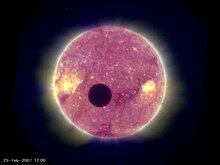Sun
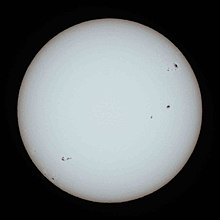 | |
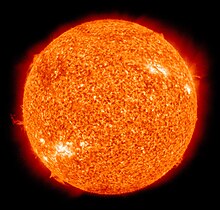 False-color image taken in 2010 as seen in ultraviolet light (wavelength of 30.4 nm) | |
| Names | Sun, Sol /ˈsɒl/,[1] Sól, Helios /ˈhiːliəs/[2] |
|---|---|
| Adjectives | Solar /ˈsoʊlər/[3] |
| Observation data | |
| Mean distance from Earth | 1 AU ≈ 1.496×108 km[4] 8 min 19 s at light speed |
| Visual brightness (V) | −26.74[5] |
| Absolute magnitude | 4.83[5] |
| Spectral classification | G2V[6] |
| Metallicity | Z = 0.0122[7] |
| Angular size | 31.6–32.7 minutes of arc[8] ≈ 0.5 degrees |
| Orbital characteristics | |
| Mean distance from Milky Way core | ≈ 2.7×1017 km ≈ 29,000 light-years |
| Galactic period | (2.25–2.50)×108 yr |
| Velocity | ≈ 220 km/s (orbit around the center of the Milky Way) ≈ 20 km/s (relative to average velocity of other stars in stellar neighborhood) ≈ 370 km/s[9] (relative to the cosmic microwave background) |
| Physical characteristics | |
| Equatorial radius | 695,700 km,[10] 696,342 km[11] 109 × Earth radii[12] |
| Equatorial circumference | 4.379×106 km[12] 109 × Earth[12] |
| Flattening | 9×10−6 |
| Surface area | 6.09×1012 km2[12] 12,000 × Earth[12] |
| Volume | 1.41×1018 km3[12] 1,300,000 × Earth |
| Mass | 1.9885×1030 kg[5] 333,000 Earths[5] |
| Average density | 1.408 g/cm3[5][12][13] 0.255 × Earth[5][12] |
| Center density (modeled) | 162.2 g/cm3[5] 12.4 × Earth |
| Equatorial surface gravity | 274 m/s2[5] 28 × Earth[12] |
| Moment of inertia factor | 0.070[5] (estimate) |
| Escape velocity (from the surface) | 617.7 km/s[12] 55 × Earth[12] |
| Temperature | Center (modeled): 1.57×107 K[5] Photosphere (effective): 5,772 K[5] Corona: ≈ 5×106 K |
| Luminosity (Lsol) | 3.828×1026 W[5] ≈ 3.75×1028 lm ≈ 98 lm/W efficacy |
| Color (B-V) | 0.63 |
| Mean radiance (Isol) | 2.009×107 W·m−2·sr−1 |
| Age | ≈ 4.6 billion years (4.6×109 years) [14][15] |
| Rotation characteristics | |
| Obliquity | 7.25°[5] (to the ecliptic) 67.23° (to the galactic plane) |
| Right ascension of North pole[16] | 286.13° 19 h 4 min 30 s |
| Declination of North pole | +63.87° 63° 52' North |
| Sidereal rotation period (at equator) | 25.05 d[5] |
| (at 16° latitude) | 25.38 d[5] 25 d 9 h 7 min 12 s[16] |
| (at poles) | 34.4 d[5] |
| Rotation velocity (at equator) | 7.189×103 km/h[12] |
| Photospheric composition (by mass) | |
| Hydrogen | 73.46%[17] |
| Helium | 24.85% |
| Oxygen | 0.77% |
| Carbon | 0.29% |
| Iron | 0.16% |
| Neon | 0.12% |
| Nitrogen | 0.09% |
| Silicon | 0.07% |
| Magnesium | 0.05% |
| Sulphur | 0.04% |
The Sun is the star at the center of the Solar System. It is a nearly perfect sphere of hot plasma,[18][19] heated to incandescence by nuclear fusion reactions in its core, radiating the energy mainly as visible light, ultraviolet light, and infrared radiation. It is by far the most important source of energy for life on Earth. Its diameter is about 1.39 million kilometres (864,000 miles), or 109 times that of Earth. Its mass is about 330,000 times that of Earth; it accounts for about 99.86% of the total mass of the Solar System.[20] Roughly three quarters of the Sun's mass consists of hydrogen (~73%); the rest is mostly helium (~25%), with much smaller quantities of heavier elements, including oxygen, carbon, neon and iron.[21]
The Sun is a G-type main-sequence star (G2V) based on its spectral class. As such, it is informally and not completely accurately referred to as a yellow dwarf (its light is closer to white than yellow). It formed approximately 4.6 billion[a][14][22] years ago from the gravitational collapse of matter within a region of a large molecular cloud. Most of this matter gathered in the center, whereas the rest flattened into an orbiting disk that became the Solar System. The central mass became so hot and dense that it eventually initiated nuclear fusion in its core. It is thought that almost all stars form by this process.
The Sun's core fuses about 600 million tons of hydrogen into helium every second, converting 4 million tons of matter into energy every second as a result. This energy, which can take between 10,000 and 170,000 years to escape the core, is the source of the Sun's light and heat. When hydrogen fusion in its core has diminished to the point at which the Sun is no longer in hydrostatic equilibrium, its core will undergo a marked increase in density and temperature while its outer layers expand, eventually transforming the Sun into a red giant. It is calculated that the Sun will become sufficiently large to engulf the current orbits of Mercury and Venus, and render Earth uninhabitable – but not for about five billion years. After this, it will shed its outer layers and become a dense type of cooling star known as a white dwarf, and no longer produce energy by fusion, but still glow and give off heat from its previous fusion.
The enormous effect of the Sun on Earth has been recognized since prehistoric times. The Sun was thought of by some cultures as a deity. The synodic rotation of Earth and its orbit around the Sun are the basis of solar calendars, one of which is the Gregorian calendar, the predominant calendar in use today.
Name and etymology
The English word sun developed from Old English sunne. Cognates appear in other Germanic languages, including West Frisian sinne, Dutch zon, Low German Sünn, Standard German Sonne, Bavarian Sunna, Old Norse sunna, and Gothic sunnō. All these words stem from Proto-Germanic *sunnōn.[23][24] This is ultimately related to the word for sun in other branches of the Indo-European language family, though in most cases a nominative stem with an l is found, rather than the genitive stem in n, as for example in Latin sōl, ancient Greek ἥλιος (hēlios), Welsh haul and Russian солнце (solntse; pronounced sontse), as well as (with *l > r) Sanskrit स्वर (svár) and Persian خور (xvar). Indeed, the l-stem survived in Proto-Germanic as well, as *sōwelan, which gave rise to Gothic sauil (alongside sunnō) and Old Norse prosaic sól (alongside poetic sunna), and through it the words for sun in the modern Scandinavian languages: Swedish and Danish solen, Icelandic sólin, etc.[24]
In English, the Greek and Latin words occur in poetry as personifications of the Sun, Helios (/ˈhiːliəs/) and Sol (/ˈsɒl/),[2][1] while in science fiction Sol may be used as a name for the Sun to distinguish it from other stars. The term sol with a lower-case s is used by planetary astronomers for the duration of a solar day on another planet such as Mars.[25]
The principal adjectives for the Sun in English are sunny for sunlight and, in technical contexts, solar (/ˈsoʊlər/),[3] from Latin sol[26] – the latter found in terms such as solar day, solar eclipse and Solar System (occasionally Sol system). From the Greek helios comes the rare adjective heliac (/ˈhiːliæk/).[27]
The English weekday name Sunday stems from Old English Sunnandæg "sun's day", a Germanic interpretation of the Latin phrase diēs sōlis, itself a translation of the ancient Greek ἡμέρα ἡλίου (hēmera hēliou) 'day of the sun'.[28]
General characteristics
The Sun is a G-type main-sequence star that constitutes about 99.86% of the mass of the Solar System. The Sun has an absolute magnitude of +4.83, estimated to be brighter than about 85% of the stars in the Milky Way, most of which are red dwarfs.[29][30] The Sun is a Population I, or heavy-element-rich,[b] star.[31] The formation of the Sun may have been triggered by shockwaves from one or more nearby supernovae.[32] This is suggested by a high abundance of heavy elements in the Solar System, such as gold and uranium, relative to the abundances of these elements in so-called Population II, heavy-element-poor, stars. The heavy elements could most plausibly have been produced by endothermic nuclear reactions during a supernova, or by transmutation through neutron absorption within a massive second-generation star.[31]
The Sun is by far the brightest object in the Earth's sky, with an apparent magnitude of −26.74.[33][34] This is about 13 billion times brighter than the next brightest star, Sirius, which has an apparent magnitude of −1.46. One astronomical unit (about 150,000,000 km; 93,000,000 mi) is defined as the mean distance of the Sun's center to Earth's center, though the distance varies as Earth moves from perihelion in January to aphelion in July.[35] The distances can vary between 147,098,074 km (perihelion) and 152,097,701 km (aphelion), and extreme values can range from 147,083,346 km to 152,112,126 km.[36] At its average distance, light travels from the Sun's horizon to Earth's horizon in about 8 minutes and 19 seconds, while light from the closest points of the Sun and Earth takes about two seconds less. The energy of this sunlight supports almost all life[c] on Earth by photosynthesis,[37] and drives Earth's climate and weather.
The Sun does not have a definite boundary, but its density decreases exponentially with increasing height above the photosphere.[38] For the purpose of measurement, the Sun's radius is considered to be the distance from its center to the edge of the photosphere, the apparent visible surface of the Sun.[39] By this measure, the Sun is a near-perfect sphere with an oblateness estimated at 9 millionths,[40] which means that its polar diameter differs from its equatorial diameter by only 10 kilometres (6.2 mi).[41] The tidal effect of the planets is weak and does not significantly affect the shape of the Sun.[42] The Sun rotates faster at its equator than at its poles. This differential rotation is caused by convective motion due to heat transport and the Coriolis force due to the Sun's rotation. In a frame of reference defined by the stars, the rotational period is approximately 25.6 days at the equator and 33.5 days at the poles. Viewed from Earth as it orbits the Sun, the apparent rotational period of the Sun at its equator is about 28 days.[43] Viewed from a vantage point above its north pole, the Sun rotates counterclockwise around its axis of spin.[d][44]
Sunlight

The solar constant is the amount of power that the Sun deposits per unit area that is directly exposed to sunlight. The solar constant is equal to approximately 1,368 W/m2 (watts per square meter) at a distance of one astronomical unit (AU) from the Sun (that is, on or near Earth).[45] Sunlight on the surface of Earth is attenuated by Earth's atmosphere, so that less power arrives at the surface (closer to 1,000 W/m2) in clear conditions when the Sun is near the zenith.[46] Sunlight at the top of Earth's atmosphere is composed (by total energy) of about 50% infrared light, 40% visible light, and 10% ultraviolet light.[47] The atmosphere in particular filters out over 70% of solar ultraviolet, especially at the shorter wavelengths.[48] Solar ultraviolet radiation ionizes Earth's dayside upper atmosphere, creating the electrically conducting ionosphere.[49]
The Sun emits light across the visible spectrum, so its color is white, with a CIE color-space index near (0.3, 0.3), when viewed from space or when the Sun is high in the sky. The Solar radiance per wavelength peaks in the green portion of the spectrum when viewed from space.[50][51] When the Sun is low in the sky, atmospheric scattering renders the Sun yellow, red, orange, or magenta. Despite its typical whiteness, most people mentally picture the Sun as yellow; the reasons for this are the subject of debate.[52] The Sun is a G2V star, with G2 indicating its surface temperature of approximately 5,778 K (5,505 °C, 9,941 °F), and V that it, like most stars, is a main-sequence star.[53][54] The average luminance of the Sun is about 1.88 giga candela per square metre, but as viewed through Earth's atmosphere, this is lowered to about 1.44 Gcd/m2.[e] However, the luminance is not constant across the disk of the Sun, due to limb darkening.
Composition
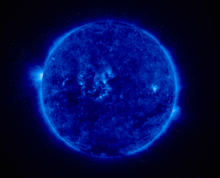
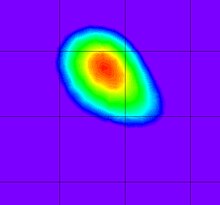

The Sun is composed primarily of the chemical elements hydrogen and helium. At this time in the Sun's life, they account for 74.9% and 23.8% of the mass of the Sun in the photosphere, respectively.[55] All heavier elements, called metals in astronomy, account for less than 2% of the mass, with oxygen (roughly 1% of the Sun's mass), carbon (0.3%), neon (0.2%), and iron (0.2%) being the most abundant.[56]
The Sun's original chemical composition was inherited from the interstellar medium out of which it formed. Originally it would have contained about 71.1% hydrogen, 27.4% helium, and 1.5% heavier elements.[55] The hydrogen and most of the helium in the Sun would have been produced by Big Bang nucleosynthesis in the first 20 minutes of the universe, and the heavier elements were produced by previous generations of stars before the Sun was formed, and spread into the interstellar medium during the final stages of stellar life and by events such as supernovae.[57]
Since the Sun formed, the main fusion process has involved fusing hydrogen into helium. Over the past 4.6 billion years, the amount of helium and its location within the Sun has gradually changed. Within the core, the proportion of helium has increased from about 24% to about 60% due to fusion, and some of the helium and heavy elements have settled from the photosphere towards the center of the Sun because of gravity. The proportions of metals (heavier elements) is unchanged. Heat is transferred outward from the Sun's core by radiation rather than by convection (see Radiative zone below), so the fusion products are not lifted outward by heat; they remain in the core[58] and gradually an inner core of helium has begun to form that cannot be fused because presently the Sun's core is not hot or dense enough to fuse helium. In the current photosphere, the helium fraction is reduced, and the metallicity is only 84% of what it was in the protostellar phase (before nuclear fusion in the core started). In the future, helium will continue to accumulate in the core, and in about 5 billion years this gradual build-up will eventually cause the Sun to exit the main sequence and become a red giant.[59]
The chemical composition of the photosphere is normally considered representative of the composition of the primordial Solar System.[60] The solar heavy-element abundances described above are typically measured both using spectroscopy of the Sun's photosphere and by measuring abundances in meteorites that have never been heated to melting temperatures. These meteorites are thought to retain the composition of the protostellar Sun and are thus not affected by the settling of heavy elements. The two methods generally agree well.[21]
Singly ionized iron-group elements
In the 1970s, much research focused on the abundances of iron-group elements in the Sun.[61][62] Although significant research was done, until 1978 it was difficult to determine the abundances of some iron-group elements (e.g. cobalt and manganese) via spectrography because of their hyperfine structures.[61]
The first largely complete set of oscillator strengths of singly ionized iron-group elements were made available in the 1960s,[63] and these were subsequently improved.[64] In 1978, the abundances of singly ionized elements of the iron group were derived.[61]
Isotopic composition
Various authors have considered the existence of a gradient in the isotopic compositions of solar and planetary noble gases,[65] e.g. correlations between isotopic compositions of neon and xenon in the Sun and on the planets.[66]
Prior to 1983, it was thought that the whole Sun has the same composition as the solar atmosphere.[67] In 1983, it was claimed that it was fractionation in the Sun itself that caused the isotopic-composition relationship between the planetary and solar-wind-implanted noble gases.[67]
Structure and fusion
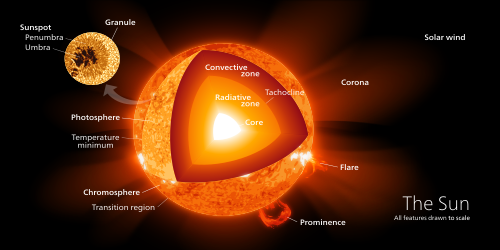
The structure of the Sun contains the following layers:
- Core – the innermost 20–25% of the Sun's radius, where temperature and pressure are sufficient for nuclear fusion to occur. Hydrogen fuses into helium (which cannot itself be fused at this point in the Sun's life). The fusion process releases energy, and the core gradually becomes enriched in helium.
- Radiative zone – Convection cannot occur until much nearer the surface of the Sun. Therefore, between about 20–25% of the radius, and 70% of the radius, there is a "radiative zone" in which energy transfer occurs by means of radiation (photons) rather than by convection.
- Tachocline – the boundary region between the radiative and convective zones.
- Convective zone – Between about 70% of the Sun's radius and a point close to the visible surface, the Sun is cool and diffuse enough for convection to occur, and this becomes the primary means of outward heat transfer, similar to weather cells which form in the earth's atmosphere.
- Because the Sun is a gaseous object, it does not have a clearly defined surface; its visible parts are usually divided into a "photosphere" and "atmosphere":
- Photosphere – the deepest part of the Sun which we can directly observe with visible light.
- Atmosphere – a gaseous "halo" surrounding the Sun, comprising the chromosphere, solar transition region, corona and heliosphere. These can be seen when the main part of the Sun is hidden, for example, during a solar eclipse.
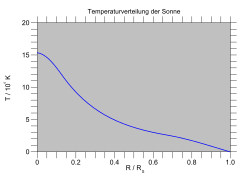
Temperature profile in the Sun

Mass inside a given radius
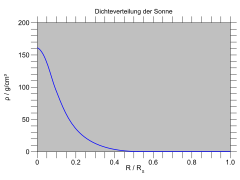
Density profile

Pressure profile
Core
The core of the Sun extends from the center to about 20–25% of the solar radius.[68] It has a density of up to 150 g/cm3[69][70] (about 150 times the density of water) and a temperature of close to 15.7 million kelvins (K).[70] By contrast, the Sun's surface temperature is approximately 5800 K. Recent analysis of SOHO mission data favors a faster rotation rate in the core than in the radiative zone above.[68] Through most of the Sun's life, energy has been produced by nuclear fusion in the core region through a series of nuclear reactions called the p–p (proton–proton) chain; this process converts hydrogen into helium.[71] Only 0.8% of the energy generated in the Sun comes from another sequence of fusion reactions called the CNO cycle, though this proportion is expected to increase as the Sun becomes older.[72][73]
The core is the only region in the Sun that produces an appreciable amount of thermal energy through fusion; 99% of the power is generated within 24% of the Sun's radius, and by 30% of the radius, fusion has stopped nearly entirely. The remainder of the Sun is heated by this energy as it is transferred outwards through many successive layers, finally to the solar photosphere where it escapes into space through radiation (photons) or advection (massive particles).[53][74]
The proton–proton chain occurs around 9.2×1037 times each second in the core, converting about 3.7×1038 protons into alpha particles (helium nuclei) every second (out of a total of ~8.9×1056 free protons in the Sun), or about 6.2×1011 kg/s.[53] Fusing four free protons (hydrogen nuclei) into a single alpha particle (helium nucleus) releases around 0.7% of the fused mass as energy,[75] so the Sun releases energy at the mass–energy conversion rate of 4.26 million metric tons per second (which requires 600 metric megatons of hydrogen [76]), for 384.6 yottawatts (3.846×1026 W),[5] or 9.192×1010 megatons of TNT per second. The large power output of the Sun is mainly due to the huge size and density of its core (compared to Earth and objects on Earth), with only a fairly small amount of power being generated per cubic metre. Theoretical models of the Sun's interior indicate a maximum power density, or energy production, of approximately 276.5 watts per cubic metre at the center of the core,[77] which is about the same power density inside a compost pile.[78][f]
The fusion rate in the core is in a self-correcting equilibrium: a slightly higher rate of fusion would cause the core to heat up more and expand slightly against the weight of the outer layers, reducing the density and hence the fusion rate and correcting the perturbation; and a slightly lower rate would cause the core to cool and shrink slightly, increasing the density and increasing the fusion rate and again reverting it to its present rate.[79][80]
Radiative zone
From the core out to about 0.7 solar radii, thermal radiation is the primary means of energy transfer.[81] The temperature drops from approximately 7 million to 2 million kelvins with increasing distance from the core.[70] This temperature gradient is less than the value of the adiabatic lapse rate and hence cannot drive convection, which explains why the transfer of energy through this zone is by radiation instead of thermal convection.[70] Ions of hydrogen and helium emit photons, which travel only a brief distance before being reabsorbed by other ions.[81] The density drops a hundredfold (from 20 g/cm3 to 0.2 g/cm3) between 0.25 solar radii and 0.7 radii, the top of the radiative zone.[81]
Tachocline
The radiative zone and the convective zone are separated by a transition layer, the tachocline. This is a region where the sharp regime change between the uniform rotation of the radiative zone and the differential rotation of the convection zone results in a large shear between the two—a condition where successive horizontal layers slide past one another.[82] Presently, it is hypothesized (see Solar dynamo) that a magnetic dynamo within this layer generates the Sun's magnetic field.[70]
Convective zone
The Sun's convection zone extends from 0.7 solar radii (500,000 km) to near the surface. In this layer, the solar plasma is not dense enough or hot enough to transfer the heat energy of the interior outward via radiation. Instead, the density of the plasma is low enough to allow convective currents to develop and move the Sun's energy outward towards its surface. Material heated at the tachocline picks up heat and expands, thereby reducing its density and allowing it to rise. As a result, an orderly motion of the mass develops into thermal cells that carry the majority of the heat outward to the Sun's photosphere above. Once the material diffusively and radiatively cools just beneath the photospheric surface, its density increases, and it sinks to the base of the convection zone, where it again picks up heat from the top of the radiative zone and the convective cycle continues. At the photosphere, the temperature has dropped to 5,700 K and the density to only 0.2 g/m3 (about 1/6,000 the density of air at sea level).[70]
The thermal columns of the convection zone form an imprint on the surface of the Sun giving it a granular appearance called the solar granulation at the smallest scale and supergranulation at larger scales. Turbulent convection in this outer part of the solar interior sustains "small-scale" dynamo action over the near-surface volume of the Sun.[70] The Sun's thermal columns are Bénard cells and take the shape of roughly hexagonal prisms.[83]
Photosphere
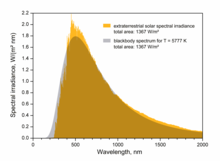
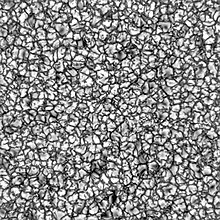
The visible surface of the Sun, the photosphere, is the layer below which the Sun becomes opaque to visible light.[84] Photons produced in this layer escape the Sun through the transparent solar atmosphere above it and become solar radiation, sunlight. The change in opacity is due to the decreasing amount of H− ions, which absorb visible light easily.[84] Conversely, the visible light we see is produced as electrons react with hydrogen atoms to produce H− ions.[85][86] The photosphere is tens to hundreds of kilometers thick, and is slightly less opaque than air on Earth. Because the upper part of the photosphere is cooler than the lower part, an image of the Sun appears brighter in the center than on the edge or limb of the solar disk, in a phenomenon known as limb darkening.[84] The spectrum of sunlight has approximately the spectrum of a black-body radiating at 5777 K, interspersed with atomic absorption lines from the tenuous layers above the photosphere. The photosphere has a particle density of ~1023 m−3 (about 0.37% of the particle number per volume of Earth's atmosphere at sea level). The photosphere is not fully ionized—the extent of ionization is about 3%, leaving almost all of the hydrogen in atomic form.[87]
During early studies of the optical spectrum of the photosphere, some absorption lines were found that did not correspond to any chemical elements then known on Earth. In 1868, Norman Lockyer hypothesized that these absorption lines were caused by a new element that he dubbed helium, after the Greek Sun god Helios. Twenty-five years later, helium was isolated on Earth.[88]
Atmosphere

During a total solar eclipse, when the disk of the Sun is covered by that of the Moon, parts of the Sun's surrounding atmosphere can be seen. It is composed of four distinct parts: the chromosphere, the transition region, the corona and the heliosphere.
The coolest layer of the Sun is a temperature minimum region extending to about 500 km above the photosphere, and has a temperature of about 4,100 K.[84] This part of the Sun is cool enough to allow the existence of simple molecules such as carbon monoxide and water, which can be detected via their absorption spectra.[89]
The chromosphere, transition region, and corona are much hotter than the surface of the Sun.[84] The reason is not well understood, but evidence suggests that Alfvén waves may have enough energy to heat the corona.[90]
Above the temperature minimum layer is a layer about 2,000 km thick, dominated by a spectrum of emission and absorption lines.[84] It is called the chromosphere from the Greek root chroma, meaning color, because the chromosphere is visible as a colored flash at the beginning and end of total solar eclipses.[81] The temperature of the chromosphere increases gradually with altitude, ranging up to around 20,000 K near the top.[84] In the upper part of the chromosphere helium becomes partially ionized.[91]
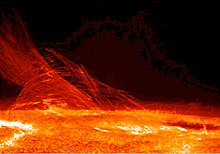
Above the chromosphere, in a thin (about 200 km) transition region, the temperature rises rapidly from around 20000 K in the upper chromosphere to coronal temperatures closer to 1000000 K.[92] The temperature increase is facilitated by the full ionization of helium in the transition region, which significantly reduces radiative cooling of the plasma.[91] The transition region does not occur at a well-defined altitude. Rather, it forms a kind of nimbus around chromospheric features such as spicules and filaments, and is in constant, chaotic motion.[81] The transition region is not easily visible from Earth's surface, but is readily observable from space by instruments sensitive to the extreme ultraviolet portion of the spectrum.[93]
The corona is the next layer of the Sun. The low corona, near the surface of the Sun, has a particle density around 1015 m−3 to 1016 m−3.[91][g] The average temperature of the corona and solar wind is about 1,000,000–2,000,000 K; however, in the hottest regions it is 8,000,000–20,000,000 K.[92] Although no complete theory yet exists to account for the temperature of the corona, at least some of its heat is known to be from magnetic reconnection.[92][94] The corona is the extended atmosphere of the Sun, which has a volume much larger than the volume enclosed by the Sun's photosphere. A flow of plasma outward from the Sun into interplanetary space is the solar wind.[94]
The heliosphere, the tenuous outermost atmosphere of the Sun, is filled with the solar wind plasma. This outermost layer of the Sun is defined to begin at the distance where the flow of the solar wind becomes superalfvénic—that is, where the flow becomes faster than the speed of Alfvén waves,[95] at approximately 20 solar radii (0.1 AU). Turbulence and dynamic forces in the heliosphere cannot affect the shape of the solar corona within, because the information can only travel at the speed of Alfvén waves. The solar wind travels outward continuously through the heliosphere,[96][97] forming the solar magnetic field into a spiral shape,[94] until it impacts the heliopause more than 50 AU from the Sun. In December 2004, the Voyager 1 probe passed through a shock front that is thought to be part of the heliopause.[98] In late 2012 Voyager 1 recorded a marked increase in cosmic ray collisions and a sharp drop in lower energy particles from the solar wind, which suggested that the probe had passed through the heliopause and entered the interstellar medium,[99] and indeed did so August 25, 2012 at approximately 122 astronomical units from the sun.[100] The heliosphere has a heliotail which stretches out behind it due to the Sun's movement.[101]
Photons and neutrinos
High-energy gamma ray photons initially released with fusion reactions in the core are almost immediately absorbed by the solar plasma of the radiative zone, usually after traveling only a few millimeters. Re-emission happens in a random direction and usually at slightly lower energy. With this sequence of emissions and absorptions, it takes a long time for radiation to reach the Sun's surface. Estimates of the photon travel time range between 10,000 and 170,000 years.[102] In contrast, it takes only 2.3 seconds for the neutrinos, which account for about 2% of the total energy production of the Sun, to reach the surface. Because energy transport in the Sun is a process that involves photons in thermodynamic equilibrium with matter, the time scale of energy transport in the Sun is longer, on the order of 30,000,000 years. This is the time it would take the Sun to return to a stable state if the rate of energy generation in its core were suddenly changed.[103]
Neutrinos are also released by the fusion reactions in the core, but, unlike photons, they rarely interact with matter, so almost all are able to escape the Sun immediately. For many years measurements of the number of neutrinos produced in the Sun were lower than theories predicted by a factor of 3. This discrepancy was resolved in 2001 through the discovery of the effects of neutrino oscillation: the Sun emits the number of neutrinos predicted by the theory, but neutrino detectors were missing 2⁄3 of them because the neutrinos had changed flavor by the time they were detected.[104]
Magnetic activity
Magnetic field




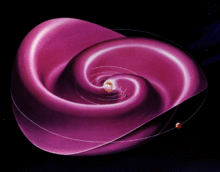
The Sun has a magnetic field that varies across its surface. Its polar field is 1–2 gauss (0.0001–0.0002 T), whereas the field is typically 3,000 gauss (0.3 T) in features on the Sun called sunspots and 10–100 gauss (0.001–0.01 T) in solar prominences.[5] The magnetic field varies in time and location. The quasi-periodic 11-year solar cycle is the most prominent variation in which the number and size of sunspots waxes and wanes.[106][107][108]
Sunspots are visible as dark patches on the Sun's photosphere and correspond to concentrations of magnetic field where the convective transport of heat is inhibited from the solar interior to the surface. As a result, sunspots are slightly cooler than the surrounding photosphere, so they appear dark. At a typical solar minimum, few sunspots are visible, and occasionally none can be seen at all. Those that do appear are at high solar latitudes. As the solar cycle progresses towards its maximum, sunspots tend to form closer to the solar equator, a phenomenon known as Spörer's law. The largest sunspots can be tens of thousands of kilometers across.[109]
An 11-year sunspot cycle is half of a 22-year Babcock–Leighton dynamo cycle, which corresponds to an oscillatory exchange of energy between toroidal and poloidal solar magnetic fields. At solar-cycle maximum, the external poloidal dipolar magnetic field is near its dynamo-cycle minimum strength, but an internal toroidal quadrupolar field, generated through differential rotation within the tachocline, is near its maximum strength. At this point in the dynamo cycle, buoyant upwelling within the convective zone forces emergence of the toroidal magnetic field through the photosphere, giving rise to pairs of sunspots, roughly aligned east–west and having footprints with opposite magnetic polarities. The magnetic polarity of sunspot pairs alternates every solar cycle, a phenomenon known as the Hale cycle.[110][111]
During the solar cycle's declining phase, energy shifts from the internal toroidal magnetic field to the external poloidal field, and sunspots diminish in number and size. At solar-cycle minimum, the toroidal field is, correspondingly, at minimum strength, sunspots are relatively rare, and the poloidal field is at its maximum strength. With the rise of the next 11-year sunspot cycle, differential rotation shifts magnetic energy back from the poloidal to the toroidal field, but with a polarity that is opposite to the previous cycle. The process carries on continuously, and in an idealized, simplified scenario, each 11-year sunspot cycle corresponds to a change, then, in the overall polarity of the Sun's large-scale magnetic field.[112][113]
The solar magnetic field extends well beyond the Sun itself. The electrically conducting solar wind plasma carries the Sun's magnetic field into space, forming what is called the interplanetary magnetic field.[94] In an approximation known as ideal magnetohydrodynamics, plasma particles only move along the magnetic field lines. As a result, the outward-flowing solar wind stretches the interplanetary magnetic field outward, forcing it into a roughly radial structure. For a simple dipolar solar magnetic field, with opposite hemispherical polarities on either side of the solar magnetic equator, a thin current sheet is formed in the solar wind.[94] At great distances, the rotation of the Sun twists the dipolar magnetic field and corresponding current sheet into an Archimedean spiral structure called the Parker spiral.[94] The interplanetary magnetic field is much stronger than the dipole component of the solar magnetic field. The Sun's dipole magnetic field of 50–400 μT (at the photosphere) reduces with the inverse-cube of the distance, leading to a predicted magnetic field of 0.1 nT at the distance of Earth. However, according to spacecraft observations the interplanetary field at Earth's location is around 5 nT, about a hundred times greater.[114] The difference is due to magnetic fields generated by electrical currents in the plasma surrounding the Sun.
Variation in activity
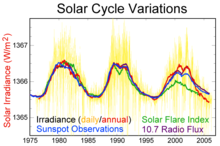
The Sun's magnetic field leads to many effects that are collectively called solar activity. Solar flares and coronal-mass ejections tend to occur at sunspot groups. Slowly changing high-speed streams of solar wind are emitted from coronal holes at the photospheric surface. Both coronal-mass ejections and high-speed streams of solar wind carry plasma and interplanetary magnetic field outward into the Solar System.[115] The effects of solar activity on Earth include auroras at moderate to high latitudes and the disruption of radio communications and electric power. Solar activity is thought to have played a large role in the formation and evolution of the Solar System.
With solar-cycle modulation of sunspot number comes a corresponding modulation of space weather conditions, including those surrounding Earth where technological systems can be affected.
In December 2019, a new type of solar magnetic explosion was observed, known as . Previously, in a process called , it was observed that the solar magnetic field lines diverge explosively and then converge again instantaneously. Forced Magnetic Reconnection was similar, but it was triggered by an explosion in the corona.[116]
Long-term change
Long-term secular change in sunspot number is thought, by some scientists, to be correlated with long-term change in solar irradiance,[117] which, in turn, might influence Earth's long-term climate.[118] For example, in the 17th century, the solar cycle appeared to have stopped entirely for several decades; few sunspots were observed during a period known as the Maunder minimum. This coincided in time with the era of the Little Ice Age, when Europe experienced unusually cold temperatures.[119] Earlier extended minima have been discovered through analysis of tree rings and appear to have coincided with lower-than-average global temperatures.[120]
A recent theory claims that there are magnetic instabilities in the core of the Sun that cause fluctuations with periods of either 41,000 or 100,000 years. These could provide a better explanation of the ice ages than the Milankovitch cycles.[121][122]
Life phases
The Sun today is roughly halfway through the most stable part of its life. It has not changed dramatically for over four billion[a] years and will remain fairly stable for more than five billion more. However, after hydrogen fusion in its core has stopped, the Sun will undergo dramatic changes, both internally and externally.
Formation
The Sun formed about 4.6 billion years ago from the collapse of part of a giant molecular cloud that consisted mostly of hydrogen and helium and that probably gave birth to many other stars.[123] This age is estimated using computer models of stellar evolution and through nucleocosmochronology.[14] The result is consistent with the radiometric date of the oldest Solar System material, at 4.567 billion years ago.[124][125] Studies of ancient meteorites reveal traces of stable daughter nuclei of short-lived isotopes, such as iron-60, that form only in exploding, short-lived stars. This indicates that one or more supernovae must have occurred near the location where the Sun formed. A shock wave from a nearby supernova would have triggered the formation of the Sun by compressing the matter within the molecular cloud and causing certain regions to collapse under their own gravity.[126] As one fragment of the cloud collapsed it also began to rotate due to conservation of angular momentum and heat up with the increasing pressure. Much of the mass became concentrated in the center, whereas the rest flattened out into a disk that would become the planets and other Solar System bodies. Gravity and pressure within the core of the cloud generated a lot of heat as it accumulated more matter from the surrounding disk, eventually triggering nuclear fusion.
HD 162826 and HD 186302 are hypothesized stellar siblings of the Sun, having formed in the same molecular cloud.
Main sequence
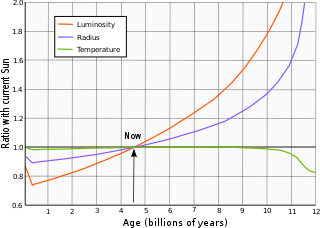
The Sun is about halfway through its main-sequence stage, during which nuclear fusion reactions in its core fuse hydrogen into helium. Each second, more than four million tonnes of matter are converted into energy within the Sun's core, producing neutrinos and solar radiation. At this rate, the Sun has so far converted around 100 times the mass of Earth into energy, about 0.03% of the total mass of the Sun. The Sun will spend a total of approximately 10 billion years as a main-sequence star.[128]
The Sun is gradually becoming hotter in its core, hotter at the surface, larger in radius, and more luminous during its time on the main sequence: since the beginning of its main sequence life, it has expanded in radius by 15% and the surface has increased in temperature from 5620 K to 5777 K, resulting in a 48% increase in luminosity from 0.677 solar luminosities to its present-day 1.0 solar luminosity. This occurs because the helium atoms in the core have a higher mean molecular weight than the hydrogen atoms that were fused, resulting in less thermal pressure. The core is therefore shrinking, allowing the outer layers of the Sun to move closer to the center, releasing gravitational potential energy. According to the virial theorem, half this released gravitational energy goes into heating, which leads to a gradual increase in the rate at which fusion occurs and thus an increase in the luminosity. This process speeds up as the core gradually becomes denser.[129] At present, it is increasing in brightness by about 1% every 100 million years. It takes at least 1 billion years from now to deplete liquid water from the Earth from such increase.[130]
After core hydrogen exhaustion

The Sun does not have enough mass to explode as a supernova. Instead, when it runs out of hydrogen in the core in approximately 5 billion years, core hydrogen fusion will stop and there will be nothing to prevent the core from contracting. The release of gravitational potential energy causes the luminosity of the star to increase, ending the main sequence phase and leading the star to expand over the next billion years: first into a subgiant, and then into a red giant.[129][131][132] The heating due to gravitational contraction will also lead to hydrogen fusion in a shell just outside the core, where unfused hydrogen remains, contributing to the increased luminosity, which will eventually reach more than 1000 times its present luminosity.[129] As a red giant, the Sun will grow so large that it will engulf Mercury, Venus, and probably Earth, reaching about 0.75AU.[132][133] The Sun will spend around a billion years as a red-giant branch star and lose around a third of its mass.[132]

After the red-giant branch, the Sun has approximately 120 million years of active life left, but much happens. First, the core, full of degenerate helium ignites violently in the helium flash, where it is estimated that 6% of the core, itself 40% of the Sun's mass, will be converted into carbon within a matter of minutes through the triple-alpha process.[134] The Sun then shrinks to around 10 times its current size and 50 times the luminosity, with a temperature a little lower than today. It will then have reached the red clump or horizontal branch, but a star of the Sun's metallicity does not evolve blueward along the horizontal branch. Instead, it just becomes moderately larger and more luminous over about 100 million years as it continues to react helium in the core.[132]
When the helium is exhausted, the Sun will repeat the expansion it followed when the hydrogen in the core was exhausted, except that this time it all happens faster, and the Sun becomes larger and more luminous. This is the asymptotic-giant-branch phase, and the Sun is alternately reacting hydrogen in a shell or helium in a deeper shell. After about 20 million years on the early asymptotic giant branch, the Sun becomes increasingly unstable, with rapid mass loss and thermal pulses that increase the size and luminosity for a few hundred years every 100,000 years or so. The thermal pulses become larger each time, with the later pulses pushing the luminosity to as much as 5,000 times the current level and the radius to over 1 AU.[135] According to a 2008 model, Earth's orbit will have initially expanded significantly due to the Sun's loss of mass as a red giant, but will later start shrinking due to tidal forces (and, eventually, drag from the lower chromosphere) so that it is engulfed by the Sun during the tip of the red-giant branch phase, 3.8 and 1 million years after Mercury and Venus have respectively suffered the same fate. Models vary depending on the rate and timing of mass loss. Models that have higher mass loss on the red-giant branch produce smaller, less luminous stars at the tip of the asymptotic giant branch, perhaps only 2,000 times the luminosity and less than 200 times the radius.[132] For the Sun, four thermal pulses are predicted before it completely loses its outer envelope and starts to make a planetary nebula. By the end of that phase—lasting approximately 500,000 years—the Sun will only have about half of its current mass.
The post-asymptotic-giant-branch evolution is even faster. The luminosity stays approximately constant as the temperature increases, with the ejected half of the Sun's mass becoming ionized into a planetary nebula as the exposed core reaches 30,000 K, as if it is in a sort of blue loop. The final naked core, a white dwarf, will have a temperature of over 100,000 K, and contain an estimated 54.05% of the Sun's present-day mass.[132] The planetary nebula will disperse in about 10,000 years, but the white dwarf will survive for trillions of years before fading to a hypothetical black dwarf.[136][137]
Motion and location
Motion in the Solar System
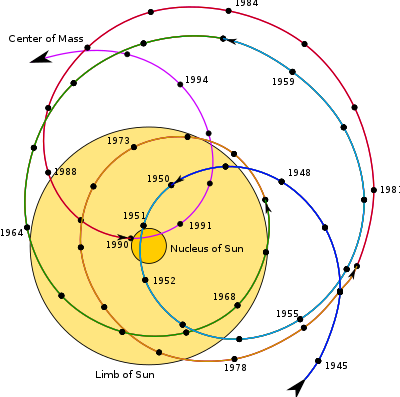
The Sun is moved by the gravitational pull of the planets. One can think of the barycentre of the Solar System as being stationary (or as moving in a steady motion around the galaxy). The centre of the sun is always within 2.2 solar radii of the barycentre. This motion of the Sun is mainly due to Jupiter, Saturn, Uranus, and Neptune. For some periods of several decades, the motion is rather regular, forming a trefoil pattern, whereas between these periods it appears more chaotic.[138] After 179 years (nine times the synodic period of Jupiter and Saturn) the pattern more or less repeats, but rotated by about 24°.[139] The orbits of the inner planets, including of the Earth, are similarly displaced by the same gravitational forces, so the movement of the Sun has little effect on the relative positions of the Earth and the Sun or on solar irradiance on the Earth as a function of time.[140]
Orbit in Milky Way
The Sun orbits the center of the Milky Way, and it is presently moving in the direction of the constellation of Cygnus. A simple model of the motion of a star in the galaxy gives the galactic coordinates X, Y, and Z as:
where U, V, and W are the respective velocities with respect to the local standard of rest, A and B are the Oort constants, is the angular velocity of galactic rotation for the local standard of rest, is the "epicyclic frequency", and ν is the vertical oscillation frequency.[141] For the sun, the present values of U, V, and W are estimated as km/s, and estimates for the other constants are A = 15.5 km/s/kpc, B = −12.2 km/s/kpc, κ = 37 km/s/kpc, and ν=74 km/s/kpc. We take X(0) and Y(0) to be zero and Z(0) is estimated to be 17 parsecs.[142] This model implies that the Sun circulates around a point that is itself going around the galaxy. The period of the Sun's circulation around the point is . which, using the equivalence that a parsec equals 1 km/s times 0.978 million years, comes to 166 million years, shorter than the time it takes for the point to go around the galaxy. In the (X, Y) coordinates, the Sun describes an ellipse around the point, whose length in the Y direction is
and whose width in the X direction is
The ratio of length to width of this ellipse, the same for all stars in our neighborhood, is The moving point is presently at
The oscillation in the Z direction takes the Sun
above the galactic plane and the same distance below it, with a period of or 83 million years, approximately 2.7 times per orbit.[143] Although is 222 million years, the value of at the point around which the Sun circulates is
(see Oort constants), corresponding to 235 million years, and this is the time that the point takes to go once around the galaxy. Other stars with the same value of have to take the same amount of time to go around the galaxy as the sun and thus remain in the same general vicinity as the Sun.
The Sun's orbit around the Milky Way is perturbed due to the non-uniform mass distribution in Milky Way, such as that in and between the galactic spiral arms. It has been argued that the Sun's passage through the higher density spiral arms often coincides with mass extinctions on Earth, perhaps due to increased impact events.[144] It takes the Solar System about 225–250 million years to complete one orbit through the Milky Way (a galactic year),[145] so it is thought to have completed 20–25 orbits during the lifetime of the Sun. The orbital speed of the Solar System about the center of the Milky Way is approximately 251 km/s (156 mi/s).[146] At this speed, it takes around 1,190 years for the Solar System to travel a distance of 1 light-year, or 7 days to travel 1 AU.[147]
The Milky Way is moving with respect to the cosmic microwave background radiation (CMB) in the direction of the constellation Hydra with a speed of 550 km/s, and the Sun's resultant velocity with respect to the CMB is about 370 km/s in the direction of Crater or Leo.[148]
Galactic location
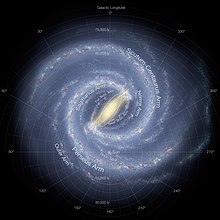
The Sun lies close to the inner rim of the Milky Way's Orion Arm, in the Local Interstellar Cloud or the Gould Belt, at a distance of 7.5–8.5 kiloparsecs (24–28 kly) from the Galactic Center.[149][150] [151][152][153][154] The Sun is contained within the Local Bubble, a space of rarefied hot gas, possibly produced by the supernova remnant Geminga,[155] or multiple supernovae in subgroup B1 of the Pleiades moving group.[156] The distance between the local arm and the next arm out, the Perseus Arm, is about 6,500 light-years.[157] The Sun, and thus the Solar System, is found in what scientists call the galactic habitable zone. The Apex of the Sun's Way, or the solar apex, is the direction that the Sun travels relative to other nearby stars. This motion is towards a point in the constellation Hercules, near the star Vega. Stars within 100 parsecs of the sun (326 light-years) have speeds relative to the sun which can be modeled approximately by a Maxwell-Boltzmann distribution (especially for the lower speeds) or a log normal distribution (especially for the higher speeds), but with more high-speed stars (greater than 300 km/s) than predicted by either distribution. The mean velocity of these stars (not the mean speed) relative to the sun (or the mean velocity of the sun relative to them) is around 20 km/s.[158]
Within 32.6 ly of the Sun there are 315 known stars in 227 systems, as of 2000, including 163 single stars. It is estimated that a further 130 systems within this range have not yet been identified. Out to 81.5 ly, there may be up to 7,500 stars, of which around 2,600 are known. The number of substellar objects in that volume are expected to be comparable to the number of stars.[159] Of the 50 nearest stellar systems within 17 light-years from Earth (the closest being the red dwarf Proxima Centauri at approximately 4.2 light-years), the Sun ranks fourth in mass.[160]
The Gaia Catalogue of Nearby Stars, all within 100 parsecs, contains 331,312 stars and is thought to include at least 92% of the stars of stellar spectral type M9 or "earlier" (i.e. hotter).[158]
Theoretical problems

Coronal heating problem
The temperature of the photosphere is approximately 6,000 K, whereas the temperature of the corona reaches 1000000–2000000 K.[92] The high temperature of the corona shows that it is heated by something other than direct heat conduction from the photosphere.[94]
It is thought that the energy necessary to heat the corona is provided by turbulent motion in the convection zone below the photosphere, and two main mechanisms have been proposed to explain coronal heating.[92] The first is wave heating, in which sound, gravitational or magnetohydrodynamic waves are produced by turbulence in the convection zone.[92] These waves travel upward and dissipate in the corona, depositing their energy in the ambient matter in the form of heat.[161] The other is magnetic heating, in which magnetic energy is continuously built up by photospheric motion and released through magnetic reconnection in the form of large solar flares and myriad similar but smaller events—nanoflares.[162]
Currently, it is unclear whether waves are an efficient heating mechanism. All waves except Alfvén waves have been found to dissipate or refract before reaching the corona.[163] In addition, Alfvén waves do not easily dissipate in the corona. Current research focus has therefore shifted towards flare heating mechanisms.[92]
Faint young Sun problem
Theoretical models of the Sun's development suggest that 3.8 to 2.5 billion years ago, during the Archean eon, the Sun was only about 75% as bright as it is today. Such a weak star would not have been able to sustain liquid water on Earth's surface, and thus life should not have been able to develop. However, the geological record demonstrates that Earth has remained at a fairly constant temperature throughout its history and that the young Earth was somewhat warmer than it is today. One theory among scientists is that the atmosphere of the young Earth contained much larger quantities of greenhouse gases (such as carbon dioxide, methane) than are present today, which trapped enough heat to compensate for the smaller amount of solar energy reaching it.[164]
However, examination of Archaean sediments appears inconsistent with the hypothesis of high greenhouse concentrations. Instead, the moderate temperature range may be explained by a lower surface albedo brought about by less continental area and the lack of biologically induced cloud condensation nuclei. This would have led to increased absorption of solar energy, thereby compensating for the lower solar output.[165]
Observational history
Early understanding

The Sun has been an object of veneration in many cultures throughout human history. Humanity's most fundamental understanding of the Sun is as the luminous disk in the sky, whose presence above the horizon causes day and whose absence causes night. In many prehistoric and ancient cultures, the Sun was thought to be a solar deity or other supernatural entity. The Sun has played an important part in many world religions, as described in a later section.
Development of scientific understanding
In the early first millennium BC, Babylonian astronomers observed that the Sun's motion along the ecliptic is not uniform, though they did not know why; it is today known that this is due to the movement of Earth in an elliptic orbit around the Sun, with Earth moving faster when it is nearer to the Sun at perihelion and moving slower when it is farther away at aphelion.[166]
One of the first people to offer a scientific or philosophical explanation for the Sun was the Greek philosopher Anaxagoras. He reasoned that it was not the chariot of Helios, but instead a giant flaming ball of metal even larger than the land of the Peloponnesus and that the Moon reflected the light of the Sun.[167] For teaching this heresy, he was imprisoned by the authorities and sentenced to death, though he was later released through the intervention of Pericles. Eratosthenes estimated the distance between Earth and the Sun in the 3rd century BC as "of stadia myriads 400 and 80000", the translation of which is ambiguous, implying either 4,080,000 stadia (755,000 km) or 804,000,000 stadia (148 to 153 million kilometers or 0.99 to 1.02 AU); the latter value is correct to within a few percent. In the 1st century AD, Ptolemy estimated the distance as 1,210 times the radius of Earth, approximately 7.71 million kilometers (0.0515 AU).[168]
The theory that the Sun is the center around which the planets orbit was first proposed by the ancient Greek Aristarchus of Samos in the 3rd century BC, and later adopted by Seleucus of Seleucia (see Heliocentrism). This view was developed in a more detailed mathematical model of a heliocentric system in the 16th century by Nicolaus Copernicus.
Observations of sunspots were recorded during the Han Dynasty (206 BC–AD 220) by Chinese astronomers, who maintained records of these observations for centuries. Averroes also provided a description of sunspots in the 12th century.[169] The invention of the telescope in the early 17th century permitted detailed observations of sunspots by Thomas Harriot, Galileo Galilei and other astronomers. Galileo posited that sunspots were on the surface of the Sun rather than small objects passing between Earth and the Sun.[170]
Arabic astronomical contributions include Al-Battani's discovery that the direction of the Sun's apogee (the place in the Sun's orbit against the fixed stars where it seems to be moving slowest) is changing.[171] (In modern heliocentric terms, this is caused by a gradual motion of the aphelion of the Earth's orbit). Ibn Yunus observed more than 10,000 entries for the Sun's position for many years using a large astrolabe.[172]

From an observation of a transit of Venus in 1032, the Persian astronomer and polymath Ibn Sina concluded that Venus is closer to Earth than the Sun.[173] In 1672 Giovanni Cassini and Jean Richer determined the distance to Mars and were thereby able to calculate the distance to the Sun.
In 1666, Isaac Newton observed the Sun's light using a prism, and showed that it is made up of light of many colors.[174] In 1800, William Herschel discovered infrared radiation beyond the red part of the solar spectrum.[175] The 19th century saw advancement in spectroscopic studies of the Sun; Joseph von Fraunhofer recorded more than 600 absorption lines in the spectrum, the strongest of which are still often referred to as Fraunhofer lines. In the early years of the modern scientific era, the source of the Sun's energy was a significant puzzle. Lord Kelvin suggested that the Sun is a gradually cooling liquid body that is radiating an internal store of heat.[176] Kelvin and Hermann von Helmholtz then proposed a gravitational contraction mechanism to explain the energy output, but the resulting age estimate was only 20 million years, well short of the time span of at least 300 million years suggested by some geological discoveries of that time.[176][177] In 1890 Joseph Lockyer, who discovered helium in the solar spectrum, proposed a meteoritic hypothesis for the formation and evolution of the Sun.[178]
Not until 1904 was a documented solution offered. Ernest Rutherford suggested that the Sun's output could be maintained by an internal source of heat, and suggested radioactive decay as the source.[179] However, it would be Albert Einstein who would provide the essential clue to the source of the Sun's energy output with his mass–energy equivalence relation E = mc2.[180] In 1920, Sir Arthur Eddington proposed that the pressures and temperatures at the core of the Sun could produce a nuclear fusion reaction that merged hydrogen (protons) into helium nuclei, resulting in a production of energy from the net change in mass.[181] The preponderance of hydrogen in the Sun was confirmed in 1925 by Cecilia Payne using the ionization theory developed by Meghnad Saha. The theoretical concept of fusion was developed in the 1930s by the astrophysicists Subrahmanyan Chandrasekhar and Hans Bethe. Hans Bethe calculated the details of the two main energy-producing nuclear reactions that power the Sun.[182][183] In 1957, Margaret Burbidge, Geoffrey Burbidge, William Fowler and Fred Hoyle showed that most of the elements in the universe have been synthesized by nuclear reactions inside stars, some like the Sun.[184]
Solar space missions

The first satellites designed for long term observation of the Sun from interplanetary space were NASA's Pioneers 6, 7, 8 and 9, which were launched between 1959 and 1968. These probes orbited the Sun at a distance similar to that of Earth, and made the first detailed measurements of the solar wind and the solar magnetic field. Pioneer 9 operated for a particularly long time, transmitting data until May 1983.[186][187]
In the 1970s, two Helios spacecraft and the Skylab Apollo Telescope Mount provided scientists with significant new data on solar wind and the solar corona. The Helios 1 and 2 probes were U.S.–German collaborations that studied the solar wind from an orbit carrying the spacecraft inside Mercury's orbit at perihelion.[188] The Skylab space station, launched by NASA in 1973, included a solar observatory module called the Apollo Telescope Mount that was operated by astronauts resident on the station.[93] Skylab made the first time-resolved observations of the solar transition region and of ultraviolet emissions from the solar corona.[93] Discoveries included the first observations of coronal mass ejections, then called "coronal transients", and of coronal holes, now known to be intimately associated with the solar wind.[188]

In 1980, the Solar Maximum Mission was launched by NASA. This spacecraft was designed to observe gamma rays, X-rays and UV radiation from solar flares during a time of high solar activity and solar luminosity. Just a few months after launch, however, an electronics failure caused the probe to go into standby mode, and it spent the next three years in this inactive state. In 1984 Space Shuttle Challenger mission STS-41C retrieved the satellite and repaired its electronics before re-releasing it into orbit. The Solar Maximum Mission subsequently acquired thousands of images of the solar corona before re-entering Earth's atmosphere in June 1989.[189]
Launched in 1991, Japan's Yohkoh (Sunbeam) satellite observed solar flares at X-ray wavelengths. Mission data allowed scientists to identify several different types of flares and demonstrated that the corona away from regions of peak activity was much more dynamic and active than had previously been supposed. Yohkoh observed an entire solar cycle but went into standby mode when an annular eclipse in 2001 caused it to lose its lock on the Sun. It was destroyed by atmospheric re-entry in 2005.[190]
One of the most important solar missions to date has been the Solar and Heliospheric Observatory, jointly built by the European Space Agency and NASA and launched on 2 December 1995.[93] Originally intended to serve a two-year mission, a mission extension through 2012 was approved in October 2009.[191] It has proven so useful that a follow-on mission, the Solar Dynamics Observatory (SDO), was launched in February 2010.[192] Situated at the Lagrangian point between Earth and the Sun (at which the gravitational pull from both is equal), SOHO has provided a constant view of the Sun at many wavelengths since its launch.[93] Besides its direct solar observation, SOHO has enabled the discovery of a large number of comets, mostly tiny sungrazing comets that incinerate as they pass the Sun.[193]
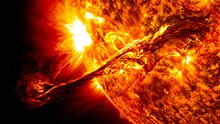
All these satellites have observed the Sun from the plane of the ecliptic, and so have only observed its equatorial regions in detail. The Ulysses probe was launched in 1990 to study the Sun's polar regions. It first traveled to Jupiter, to "slingshot" into an orbit that would take it far above the plane of the ecliptic. Once Ulysses was in its scheduled orbit, it began observing the solar wind and magnetic field strength at high solar latitudes, finding that the solar wind from high latitudes was moving at about 750 km/s, which was slower than expected, and that there were large magnetic waves emerging from high latitudes that scattered galactic cosmic rays.[194]
Elemental abundances in the photosphere are well known from spectroscopic studies, but the composition of the interior of the Sun is more poorly understood. A solar wind sample return mission, Genesis, was designed to allow astronomers to directly measure the composition of solar material.[195]
The Solar Terrestrial Relations Observatory (STEREO) mission was launched in October 2006. Two identical spacecraft were launched into orbits that cause them to (respectively) pull further ahead of and fall gradually behind Earth. This enables stereoscopic imaging of the Sun and solar phenomena, such as coronal mass ejections.[196][197]
The Parker Solar Probe was launched in 2018 aboard a Delta IV Heavy rocket and will reach a perigee of 0.046 AU in 2025, making it the closest-orbiting manmade satellite as the first spacecraft to fly low into the solar corona.[198]
The Indian Space Research Organisation has scheduled the launch of a 100 kg satellite named Aditya for mid 2020. Its main instrument will be a coronagraph for studying the dynamics of the solar corona.[199]
Observation and effects

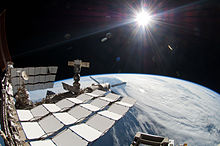
The brightness of the Sun can cause pain from looking at it with the naked eye; however, doing so for brief periods is not hazardous for normal non-dilated eyes.[200][201] Looking directly at the Sun causes phosphene visual artifacts and temporary partial blindness. Looking at sun directly is known as sungazing. It also delivers about 4 milliwatts of sunlight to the retina, slightly heating it and potentially causing damage in eyes that cannot respond properly to the brightness.[202][203] UV exposure gradually yellows the lens of the eye over a period of years, and is thought to contribute to the formation of cataracts, but this depends on general exposure to solar UV, and not whether one looks directly at the Sun.[204] Long-duration viewing of the direct Sun with the naked eye can begin to cause UV-induced, sunburn-like lesions on the retina after about 100 seconds, particularly under conditions where the UV light from the Sun is intense and well focused;[205][206] conditions are worsened by young eyes or new lens implants (which admit more UV than aging natural eyes), Sun angles near the zenith, and observing locations at high altitude.
Viewing the Sun through light-concentrating optics such as binoculars may result in permanent damage to the retina without an appropriate filter that blocks UV and substantially dims the sunlight. When using an attenuating filter to view the Sun, the viewer is cautioned to use a filter specifically designed for that use. Some improvised filters that pass UV or IR rays, can actually harm the eye at high brightness levels.[207] Herschel wedges, also called Solar Diagonals, are effective and inexpensive for small telescopes. The sunlight that is destined for the eyepiece is reflected from an unsilvered surface of a piece of glass. Only a very small fraction of the incident light is reflected. The rest passes through the glass and leaves the instrument. If the glass breaks because of the heat, no light at all is reflected, making the device fail-safe. Simple filters made of darkened glass allow the full intensity of sunlight to pass through if they break, endangering the observer's eyesight. Unfiltered binoculars can deliver hundreds of times as much energy as using the naked eye, possibly causing immediate damage. It is claimed that even brief glances at the midday Sun through an unfiltered telescope can cause permanent damage.[208]

Partial solar eclipses are hazardous to view because the eye's pupil is not adapted to the unusually high visual contrast: the pupil dilates according to the total amount of light in the field of view, not by the brightest object in the field. During partial eclipses, most sunlight is blocked by the Moon passing in front of the Sun, but the uncovered parts of the photosphere have the same surface brightness as during a normal day. In the overall gloom, the pupil expands from ~2 mm to ~6 mm, and each retinal cell exposed to the solar image receives up to ten times more light than it would looking at the non-eclipsed Sun. This can damage or kill those cells, resulting in small permanent blind spots for the viewer.[209] The hazard is insidious for inexperienced observers and for children because there is no perception of pain: it is not immediately obvious that one's vision is being destroyed.

During sunrise and sunset, sunlight is attenuated because of Rayleigh scattering and Mie scattering from a particularly long passage through Earth's atmosphere,[210] and the Sun is sometimes faint enough to be viewed comfortably with the naked eye or safely with optics (provided there is no risk of bright sunlight suddenly appearing through a break between clouds). Hazy conditions, atmospheric dust, and high humidity contribute to this atmospheric attenuation.[211]
An optical phenomenon, known as a green flash, can sometimes be seen shortly after sunset or before sunrise. The flash is caused by light from the Sun just below the horizon being bent (usually through a temperature inversion) towards the observer. Light of shorter wavelengths (violet, blue, green) is bent more than that of longer wavelengths (yellow, orange, red) but the violet and blue light is scattered more, leaving light that is perceived as green.[212]
Ultraviolet light from the Sun has antiseptic properties and can be used to sanitize tools and water. It also causes sunburn, and has other biological effects such as the production of vitamin D and sun tanning. It is also the main cause of skin cancer. Ultraviolet light is strongly attenuated by Earth's ozone layer, so that the amount of UV varies greatly with latitude and has been partially responsible for many biological adaptations, including variations in human skin color in different regions of the Earth.[213]
Planetary system
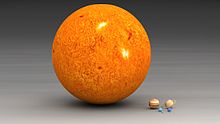
The Sun has eight known planets. This includes four terrestrial planets (Mercury, Venus, Earth, and Mars), two gas giants (Jupiter and Saturn), and two ice giants (Uranus and Neptune). The Solar System also has at least five dwarf planets, an asteroid belt, numerous comets, and a large number of icy bodies which lie beyond the orbit of Neptune.
Religious aspects
Worship of the Sun was central to civilizations such as the ancient Egyptians, the Inca of South America and the Aztecs of what is now Mexico. In religions such as Hinduism, the Sun is still considered a god. Many ancient monuments were constructed with solar phenomena in mind; for example, stone megaliths accurately mark the summer or winter solstice (some of the most prominent megaliths are located in Nabta Playa, Egypt; Mnajdra, Malta and at Stonehenge, England); Newgrange, a prehistoric human-built mount in Ireland, was designed to detect the winter solstice; the pyramid of El Castillo at Chichén Itzá in Mexico is designed to cast shadows in the shape of serpents climbing the pyramid at the vernal and autumnal equinoxes.
The Egyptians portrayed the god Ra as being carried across the sky in a solar barque, accompanied by lesser gods, and to the Greeks, he was Helios, carried by a chariot drawn by fiery horses. From the reign of Elagabalus in the late Roman Empire the Sun's birthday was a holiday celebrated as Sol Invictus (literally "Unconquered Sun") soon after the winter solstice, which may have been an antecedent to Christmas. Regarding the fixed stars, the Sun appears from Earth to revolve once a year along the ecliptic through the zodiac, and so Greek astronomers categorized it as one of the seven planets (Greek planetes, "wanderer"); the naming of the days of the weeks after the seven planets dates to the Roman era.[214][215][216]
Solar deities play a major role in many world religions and mythologies.[217] The ancient Sumerians believed that the Sun was Utu,[218][219] the god of justice and twin brother of Inanna, the Queen of Heaven,[218] who was identified as the planet Venus.[219] Later, Utu was identified with the East Semitic god Shamash.[218][219] Utu was regarded as a helper-deity, who aided those in distress,[218] and, in iconography, he is usually portrayed with a long beard and clutching a saw,[218] which represented his role as the dispenser of justice.[218]
From at least the Fourth Dynasty of Ancient Egypt, the Sun was worshipped as the god Ra, portrayed as a falcon-headed divinity surmounted by the solar disk, and surrounded by a serpent. In the New Empire period, the Sun became identified with the dung beetle, whose spherical ball of dung was identified with the Sun. In the form of the sun disc Aten, the Sun had a brief resurgence during the Amarna Period when it again became the preeminent, if not only, divinity for the Pharaoh Akhenaton.[220][221]
In Proto-Indo-European religion, the Sun was personified as the goddess *Seh2ul.[222][223] Derivatives of this goddess in Indo-European languages include the Old Norse Sól, Sanskrit Surya, Gaulish Sulis, Lithuanian Saulė, and Slavic Solntse.[223] In ancient Greek religion, the sun deity was the male god Helios,[224] but traces of an earlier female solar deity are preserved in Helen of Troy.[224] In later times, Helios was syncretized with Apollo.[225]
In the Bible, Malachi 4:2 mentions the "Sun of Righteousness" (sometimes translated as the "Sun of Justice"),[226] which some Christians have interpreted as a reference to the Messiah (Christ).[227] In ancient Roman culture, Sunday was the day of the sun god. It was adopted as the Sabbath day by Christians who did not have a Jewish background. The symbol of light was a pagan device adopted by Christians, and perhaps the most important one that did not come from Jewish traditions. In paganism, the Sun was a source of life, giving warmth and illumination to mankind. It was the center of a popular cult among Romans, who would stand at dawn to catch the first rays of sunshine as they prayed. The celebration of the winter solstice (which influenced Christmas) was part of the Roman cult of the unconquered Sun (Sol Invictus). Christian churches were built with an orientation so that the congregation faced toward the sunrise in the East.[228]
Tonatiuh, the Aztec god of the sun, was usually depicted holding arrows and a shield[229] and was closely associated with the practice of human sacrifice.[229] The sun goddess Amaterasu is the most important deity in the Shinto religion,[230][231] and she is believed to be the direct ancestor of all Japanese emperors.[230]
See also
- Advanced Composition Explorer
- Antisolar point
- List of brightest stars
- Midnight sun
- Sun path
- Sun-Earth Day
- Sungazing
- Timeline of the far future
- Analemma
Notes
- ^ Jump up to: a b All numbers in this article are short scale. One billion is 109, or 1,000,000,000.
- ^ In astronomical sciences, the term heavy elements (or metals) refers to all chemical elements except hydrogen and helium.
- ^ Hydrothermal vent communities live so deep under the sea that they have no access to sunlight. Bacteria instead use sulfur compounds as an energy source, via chemosynthesis.
- ^ Counterclockwise is also the direction of revolution around the Sun for objects in the Solar System and is the direction of axial spin for most objects.
- ^ 1.88 Gcd/m2 is calculated from the solar illuminance of 128000 lux (see sunlight) times the square of the distance to the center of the Sun, divided by the cross sectional area of the Sun. 1.44 Gcd/m2 is calculated using 98000 lux.
- ^ A 50 kg adult human has a volume of about 0.05 m3, which corresponds to 13.8 watts, at the volumetric power of the solar center. This is 285 kcal/day, about 10% of the actual average caloric intake and output for humans in non-stressful conditions.
- ^ Earth's atmosphere near sea level has a particle density of about 2×1025 m−3.
References
- ^ Jump up to: a b "Sol". Oxford English Dictionary (Online ed.). Oxford University Press. (Subscription or participating institution membership required.)
- ^ Jump up to: a b "Helios". Lexico UK Dictionary. Oxford University Press.
- ^ Jump up to: a b "solar". Oxford English Dictionary (Online ed.). Oxford University Press. (Subscription or participating institution membership required.)
- ^ Pitjeva, E. V.; Standish, E. M. (2009). "Proposals for the masses of the three largest asteroids, the Moon–Earth mass ratio and the Astronomical Unit". Celestial Mechanics and Dynamical Astronomy. 103 (4): 365–372. Bibcode:2009CeMDA.103..365P. doi:10.1007/s10569-009-9203-8. ISSN 1572-9478. S2CID 121374703.
- ^ Jump up to: a b c d e f g h i j k l m n o p q r Williams, D.R. (1 July 2013). "Sun Fact Sheet". NASA Goddard Space Flight Center. Archived from the original on 15 July 2010. Retrieved 12 August 2013.
- ^ Zombeck, Martin V. (1990). Handbook of Space Astronomy and Astrophysics 2nd edition. Cambridge University Press.
- ^ Asplund, M.; Grevesse, N.; Sauval, A.J. (2006). "The new solar abundances – Part I: the observations". Communications in Asteroseismology. 147: 76–79. Bibcode:2006CoAst.147...76A. doi:10.1553/cia147s76. S2CID 123824232.
- ^ "Eclipse 99: Frequently Asked Questions". NASA. Archived from the original on 27 May 2010. Retrieved 24 October 2010.
- ^ Hinshaw, G.; et al. (2009). "Five-year Wilkinson Microwave Anisotropy Probe observations: data processing, sky maps, and basic results". The Astrophysical Journal Supplement Series. 180 (2): 225–245. arXiv:0803.0732. Bibcode:2009ApJS..180..225H. doi:10.1088/0067-0049/180/2/225. S2CID 3629998.
- ^ Mamajek, E.E.; Prsa, A.; Torres, G.; et, al. (2015), "IAU 2015 Resolution B3 on Recommended Nominal Conversion Constants for Selected Solar and Planetary Properties", arXiv:1510.07674 [astro-ph.SR]
- ^ Emilio, Marcelo; Kuhn, Jeff R.; Bush, Rock I.; Scholl, Isabelle F. (2012), "Measuring the Solar Radius from Space during the 2003 and 2006 Mercury Transits", The Astrophysical Journal, 750 (2): 135, arXiv:1203.4898, Bibcode:2012ApJ...750..135E, doi:10.1088/0004-637X/750/2/135, S2CID 119255559
- ^ Jump up to: a b c d e f g h i j k l "Solar System Exploration: Planets: Sun: Facts & Figures". NASA. Archived from the original on 2 January 2008.
- ^ Ko, M. (1999). Elert, G. (ed.). "Density of the Sun". The Physics Factbook.
- ^ Jump up to: a b c Bonanno, A.; Schlattl, H.; Paternò, L. (2002). "The age of the Sun and the relativistic corrections in the EOS". Astronomy and Astrophysics. 390 (3): 1115–1118. arXiv:astro-ph/0204331. Bibcode:2002A&A...390.1115B. doi:10.1051/0004-6361:20020749.
- ^ Connelly, JN; Bizzarro, M; Krot, AN; Nordlund, Å; Wielandt, D; Ivanova, MA (2 November 2012). "The Absolute Chronology and Thermal Processing of Solids in the Solar Protoplanetary Disk". Science. 338 (6107): 651–655. Bibcode:2012Sci...338..651C. doi:10.1126/science.1226919. PMID 23118187. S2CID 21965292.(registration required)
- ^ Jump up to: a b Seidelmann, P.K.; et al. (2000). "Report Of The IAU/IAG Working Group On Cartographic Coordinates And Rotational Elements Of The Planets And Satellites: 2000". Archived from the original on 12 May 2020. Retrieved 22 March 2006.
- ^ "The Sun's Vital Statistics". Stanford Solar Center. Retrieved 29 July 2008. Citing Eddy, J. (1979). A New Sun: The Solar Results From Skylab. NASA. p. 37. NASA SP-402.
- ^ "How Round is the Sun?". NASA. 2 October 2008. Retrieved 7 March 2011.
- ^ "First Ever STEREO Images of the Entire Sun". NASA. 6 February 2011. Retrieved 7 March 2011.
- ^ Woolfson, M. (2000). "The origin and evolution of the solar system" (PDF). Astronomy & Geophysics. 41 (1): 12. Bibcode:2000A&G....41a..12W. doi:10.1046/j.1468-4004.2000.00012.x.
- ^ Jump up to: a b Basu, S.; Antia, H.M. (2008). "Helioseismology and Solar Abundances". Physics Reports. 457 (5–6): 217–283. arXiv:0711.4590. Bibcode:2008PhR...457..217B. doi:10.1016/j.physrep.2007.12.002. S2CID 119302796.
- ^ Connelly, James N.; Bizzarro, Martin; Krot, Alexander N.; Nordlund, Åke; Wielandt, Daniel; Ivanova, Marina A. (2 November 2012). "The Absolute Chronology and Thermal Processing of Solids in the Solar Protoplanetary Disk". Science. 338 (6107): 651–655. Bibcode:2012Sci...338..651C. doi:10.1126/science.1226919. PMID 23118187. S2CID 21965292.
- ^ Barnhart, R.K. (1995). The Barnhart Concise Dictionary of Etymology. HarperCollins. p. 776. ISBN 978-0-06-270084-1.
- ^ Jump up to: a b Vladimir Orel (2003) A Handbook of Germanic Etymology, Brill
- ^ "Opportunity's View, Sol 959 (Vertical)". NASA. 15 November 2006. Retrieved 1 August 2007.
- ^ Little, William; Fowler, H.W.; Coulson, J. (1955). "Sol". Oxford Universal Dictionary on Historical Principles (3rd ed.). ASIN B000QS3QVQ.
- ^ "heliac". Oxford English Dictionary (Online ed.). Oxford University Press. (Subscription or participating institution membership required.)
- ^ Barnhart, R.K. (1995). The Barnhart Concise Dictionary of Etymology. HarperCollins. p. 778. ISBN 978-0-06-270084-1.
- ^ Than, K. (2006). "Astronomers Had it Wrong: Most Stars are Single". Space.com. Retrieved 1 August 2007.
- ^ Lada, C.J. (2006). "Stellar multiplicity and the initial mass function: Most stars are single". Astrophysical Journal Letters. 640 (1): L63–L66. arXiv:astro-ph/0601375. Bibcode:2006ApJ...640L..63L. doi:10.1086/503158. S2CID 8400400.
- ^ Jump up to: a b Zeilik, M.A.; Gregory, S.A. (1998). Introductory Astronomy & Astrophysics (4th ed.). Saunders College Publishing. p. 322. ISBN 978-0-03-006228-5.
- ^ Falk, S.W.; Lattmer, J.M.; Margolis, S.H. (1977). "Are supernovae sources of presolar grains?". Nature. 270 (5639): 700–701. Bibcode:1977Natur.270..700F. doi:10.1038/270700a0. S2CID 4240932.
- ^ Burton, W.B. (1986). "Stellar parameters". Space Science Reviews. 43 (3–4): 244–250. doi:10.1007/BF00190626. S2CID 189796439.
- ^ Bessell, M.S.; Castelli, F.; Plez, B. (1998). "Model atmospheres broad-band colors, bolometric corrections and temperature calibrations for O–M stars". Astronomy and Astrophysics. 333: 231–250. Bibcode:1998A&A...333..231B.
- ^ "Equinoxes, Solstices, Perihelion, and Aphelion, 2000–2020". US Naval Observatory. 31 January 2008. Retrieved 17 July 2009.
- ^ "Earth at Perihelion and Aphelion: 2001 to 2100". Retrieved 3 June 2021.
- ^ Simon, A. (2001). The Real Science Behind the X-Files : Microbes, meteorites, and mutants. Simon & Schuster. pp. 25–27. ISBN 978-0-684-85618-6.
- ^ Beer, J.; McCracken, K.; von Steiger, R. (2012). Cosmogenic Radionuclides: Theory and Applications in the Terrestrial and Space Environments. Springer Science+Business Media. p. 41. ISBN 978-3-642-14651-0.
- ^ Phillips, K.J.H. (1995). Guide to the Sun. Cambridge University Press. p. 73. ISBN 978-0-521-39788-9.
- ^ Godier, S.; Rozelot, J.-P. (2000). "The solar oblateness and its relationship with the structure of the tachocline and of the Sun's subsurface" (PDF). Astronomy and Astrophysics. 355: 365–374. Bibcode:2000A&A...355..365G. Archived from the original (PDF) on 10 May 2011. Retrieved 22 February 2006.
- ^ Jones, G. (16 August 2012). "Sun is the most perfect sphere ever observed in nature". The Guardian. Retrieved 19 August 2013.
- ^ Schutz, B.F. (2003). Gravity from the ground up. Cambridge University Press. pp. 98–99. ISBN 978-0-521-45506-0.
- ^ Phillips, K.J.H. (1995). Guide to the Sun. Cambridge University Press. pp. 78–79. ISBN 978-0-521-39788-9.
- ^ "The Anticlockwise Solar System". www.spaceacademy.net.au. Australian Space Academy.
- ^ "Construction of a Composite Total Solar Irradiance (TSI) Time Series from 1978 to present". Archived from the original on 1 August 2011. Retrieved 5 October 2005.
- ^ El-Sharkawi, Mohamed A. (2005). Electric energy. CRC Press. pp. 87–88. ISBN 978-0-8493-3078-0.
- ^ "Solar radiation" (PDF).
- ^ "Reference Solar Spectral Irradiance: Air Mass 1.5". Retrieved 12 November 2009.
- ^ Phillips, K.J.H. (1995). Guide to the Sun. Cambridge University Press. pp. 14–15, 34–38. ISBN 978-0-521-39788-9.
- ^ "What Color is the Sun?". Universe Today. Retrieved 23 May 2016.
- ^ "What Color is the Sun?". Stanford Solar Center. Retrieved 23 May 2016.
- ^ Wilk, S.R. (2009). "The Yellow Sun Paradox". Optics & Photonics News: 12–13. Archived from the original on 18 June 2012.
- ^ Jump up to: a b c Phillips, K.J.H. (1995). Guide to the Sun. Cambridge University Press. pp. 47–53. ISBN 978-0-521-39788-9.
- ^ Karl S. Kruszelnicki (17 April 2012). "Dr Karl's Great Moments In Science: Lazy Sun is less energetic than compost". Australian Broadcasting Corporation. Retrieved 25 February 2014.
Every second, the Sun burns 620 million tonnes of hydrogen...
- ^ Jump up to: a b
Lodders, Katharina (10 July 2003). "Solar System Abundances and Condensation Temperatures of the Elements" (PDF). The Astrophysical Journal. 591 (2): 1220–1247. Bibcode:2003ApJ...591.1220L. CiteSeerX 10.1.1.666.9351. doi:10.1086/375492. Archived from the original (PDF) on 7 November 2015. Retrieved 1 September 2015.
Lodders, K. (2003). "Abundances and Condensation Temperatures of the Elements" (PDF). Meteoritics & Planetary Science. 38 (suppl): 5272. Bibcode:2003M&PSA..38.5272L. - ^ Hansen, C.J.; Kawaler, S.A.; Trimble, V. (2004). Stellar Interiors: Physical Principles, Structure, and Evolution (2nd ed.). Springer. pp. 19–20. ISBN 978-0-387-20089-7.
- ^ Hansen, C.J.; Kawaler, S.A.; Trimble, V. (2004). Stellar Interiors: Physical Principles, Structure, and Evolution (2nd ed.). Springer. pp. 77–78. ISBN 978-0-387-20089-7.
- ^ Hansen, C.J.; Kawaler, S.A.; Trimble, V. (2004). Stellar Interiors: Physical Principles, Structure, and Evolution (2nd ed.). Springer. § 9.2.3. ISBN 978-0-387-20089-7.
- ^ Iben, I Jnr (1965) "Stellar Evolution. II. The Evolution of a 3 M_{sun} Star from the Main Sequence Through Core Helium Burning". (Astrophysical Journal, vol. 142, p. 1447)
- ^ Aller, L.H. (1968). "The chemical composition of the Sun and the solar system". Proceedings of the Astronomical Society of Australia. 1 (4): 133. Bibcode:1968PASA....1..133A. doi:10.1017/S1323358000011048.
- ^ Jump up to: a b c Biemont, E. (1978). "Abundances of singly ionized elements of the iron group in the Sun". Monthly Notices of the Royal Astronomical Society. 184 (4): 683–694. Bibcode:1978MNRAS.184..683B. doi:10.1093/mnras/184.4.683.
- ^ Ross and Aller 1976, Withbroe 1976, Hauge and Engvold 1977, cited in Biemont 1978.
- ^ Corliss and Bozman (1962 cited in Biemont 1978) and Warner (1967 cited in Biemont 1978)
- ^ Smith (1976 cited in Biemont 1978)
- ^ Signer and Suess 1963; Manuel 1967; Marti 1969; Kuroda and Manuel 1970; Srinivasan and Manuel 1971, all cited in Manuel and Hwaung 1983
- ^ Kuroda and Manuel 1970 cited in Manuel and Hwaung 1983:7
- ^ Jump up to: a b Manuel, O.K.; Hwaung, G. (1983). "Solar abundances of the elements". Meteoritics. 18 (3): 209–222. Bibcode:1983Metic..18..209M. doi:10.1111/j.1945-5100.1983.tb00822.x.
- ^ Jump up to: a b García, R.; et al. (2007). "Tracking solar gravity modes: the dynamics of the solar core". Science. 316 (5831): 1591–1593. Bibcode:2007Sci...316.1591G. doi:10.1126/science.1140598. PMID 17478682. S2CID 35285705.
- ^ Basu, S.; et al. (2009). "Fresh insights on the structure of the solar core". The Astrophysical Journal. 699 (2): 1403–1417. arXiv:0905.0651. Bibcode:2009ApJ...699.1403B. doi:10.1088/0004-637X/699/2/1403. S2CID 11044272.
- ^ Jump up to: a b c d e f g "NASA/Marshall Solar Physics". Marshall Space Flight Center. 18 January 2007. Retrieved 11 July 2009.
- ^ Broggini, C. (2003). Physics in Collision, Proceedings of the XXIII International Conference: Nuclear Processes at Solar Energy. XXIII Physics in Collisions Conference. Zeuthen, Germany. p. 21. arXiv:astro-ph/0308537. Bibcode:2003phco.conf...21B.
- ^ Goupil, M.J.; Lebreton, Y.; Marques, J.P.; Samadi, R.; Baudin, F. (2011). "Open issues in probing interiors of solar-like oscillating main sequence stars 1. From the Sun to nearly suns". Journal of Physics: Conference Series. 271 (1): 012031. arXiv:1102.0247. Bibcode:2011JPhCS.271a2031G. doi:10.1088/1742-6596/271/1/012031. S2CID 4776237.
- ^ The Borexino Collaboration (2020). "Experimental evidence of neutrinos produced in the CNO fusion cycle in the Sun". Nature. 587 (?): 577–582. arXiv:2006.15115. Bibcode:2020Natur.587..577B. doi:10.1038/s41586-020-2934-0. PMID 33239797. S2CID 227174644.
- ^ Zirker, J.B. (2002). Journey from the Center of the Sun. Princeton University Press. pp. 15–34. ISBN 978-0-691-05781-1.
- ^ Shu, F.H. (1982). The Physical Universe: An Introduction to Astronomy. University Science Books. p. 102. ISBN 978-0-935702-05-7.
- ^ "Ask Us: Sun". Cosmicopia. NASA. 2012. Archived from the original on 3 September 2018. Retrieved 13 July 2017.
- ^ Cohen, H. (9 November 1998). "Table of temperatures, power densities, luminosities by radius in the Sun". Contemporary Physics Education Project. Archived from the original on 29 November 2001. Retrieved 30 August 2011.
- ^ "Lazy Sun is less energetic than compost". 17 April 2012.
- ^ Haubold, H.J.; Mathai, A.M. (1994). "Solar Nuclear Energy Generation & The Chlorine Solar Neutrino Experiment". AIP Conference Proceedings. 320 (1994): 102–116. arXiv:astro-ph/9405040. Bibcode:1995AIPC..320..102H. CiteSeerX 10.1.1.254.6033. doi:10.1063/1.47009. S2CID 14622069.
- ^ Myers, S.T. (18 February 1999). "Lecture 11 – Stellar Structure I: Hydrostatic Equilibrium". Introduction to Astrophysics II. Retrieved 15 July 2009.
- ^ Jump up to: a b c d e "Sun". World Book at NASA. NASA. Archived from the original on 10 May 2013. Retrieved 10 October 2012.
- ^ Tobias, S.M. (2005). "The solar tachocline: Formation, stability and its role in the solar dynamo". In A.M. Soward; et al. (eds.). Fluid Dynamics and Dynamos in Astrophysics and Geophysics. CRC Press. pp. 193–235. ISBN 978-0-8493-3355-2.
- ^ Mullan, D.J (2000). "Solar Physics: From the Deep Interior to the Hot Corona". In Page, D.; Hirsch, J.G. (eds.). From the Sun to the Great Attractor. Springer. p. 22. ISBN 978-3-540-41064-5.
- ^ Jump up to: a b c d e f g Abhyankar, K.D. (1977). "A Survey of the Solar Atmospheric Models". Bulletin of the Astronomical Society of India. 5: 40–44. Bibcode:1977BASI....5...40A.
- ^ Gibson, Edward G. (1973). The Quiet Sun (NASA SP-303). NASA. ASIN B0006C7RS0.
- ^ Shu, F.H. (1991). The Physics of Astrophysics. 1. University Science Books. ISBN 978-0-935702-64-4.
- ^ Rast, M.; Nordlund, Å.; Stein, R.; Toomre, J. (1993). "Ionization Effects in Three-Dimensional Solar Granulation Simulations". The Astrophysical Journal Letters. 408 (1): L53–L56. Bibcode:1993ApJ...408L..53R. doi:10.1086/186829.
- ^ Parnel, C. "Discovery of Helium". University of St Andrews. Retrieved 22 March 2006.
- ^ Solanki, S.K.; Livingston, W.; Ayres, T. (1994). "New Light on the Heart of Darkness of the Solar Chromosphere". Science. 263 (5143): 64–66. Bibcode:1994Sci...263...64S. doi:10.1126/science.263.5143.64. PMID 17748350. S2CID 27696504.
- ^ De Pontieu, B.; et al. (2007). "Chromospheric Alfvénic Waves Strong Enough to Power the Solar Wind". Science. 318 (5856): 1574–1577. Bibcode:2007Sci...318.1574D. doi:10.1126/science.1151747. PMID 18063784. S2CID 33655095.
- ^ Jump up to: a b c Hansteen, V.H.; Leer, E.; Holzer, T.E. (1997). "The role of helium in the outer solar atmosphere". The Astrophysical Journal. 482 (1): 498–509. Bibcode:1997ApJ...482..498H. doi:10.1086/304111.
- ^ Jump up to: a b c d e f g Erdèlyi, R.; Ballai, I. (2007). "Heating of the solar and stellar coronae: a review". Astron. Nachr. 328 (8): 726–733. Bibcode:2007AN....328..726E. doi:10.1002/asna.200710803.
- ^ Jump up to: a b c d e Dwivedi, B.N. (2006). "Our ultraviolet Sun" (PDF). Current Science. 91 (5): 587–595.
- ^ Jump up to: a b c d e f g Russell, C.T. (2001). "Solar wind and interplanetary magnetic filed: A tutorial" (PDF). In Song, Paul; Singer, Howard J.; Siscoe, George L. (eds.). Space Weather (Geophysical Monograph). American Geophysical Union. pp. 73–88. ISBN 978-0-87590-984-4.
- ^ A.G, Emslie; J.A., Miller (2003). "Particle Acceleration". In Dwivedi, B.N. (ed.). Dynamic Sun. Cambridge University Press. p. 275. ISBN 978-0-521-81057-9.
- ^ "A Star with two North Poles". Science @ NASA. NASA. 22 April 2003. Archived from the original on 18 July 2009.
- ^ Riley, P.; Linker, J.A.; Mikić, Z. (2002). "Modeling the heliospheric current sheet: Solar cycle variations". Journal of Geophysical Research. 107 (A7): SSH 8–1. Bibcode:2002JGRA..107.1136R. doi:10.1029/2001JA000299. CiteID 1136.
- ^ "The Distortion of the Heliosphere: Our Interstellar Magnetic Compass" (Press release). European Space Agency. 2005. Retrieved 22 March 2006.
- ^ Anderson, Rupert W. (2015). The Cosmic Compendium: Interstellar Travel. pp. 163–164. ISBN 978-1-329-02202-7.
- ^ "Voyager - the Interstellar Mission".
- ^ Dunbar, Brian (2 March 2015). "Components of the Heliosphere". NASA. Retrieved 20 March 2021.
- ^ "Ancient sunlight". Technology Through Time. NASA. 2007. Archived from the original on 15 May 2009. Retrieved 24 June 2009.
- ^ Stix, M. (2003). "On the time scale of energy transport in the sun". Solar Physics. 212 (1): 3–6. Bibcode:2003SoPh..212....3S. doi:10.1023/A:1022952621810. S2CID 118656812.
- ^ Schlattl, H. (2001). "Three-flavor oscillation solutions for the solar neutrino problem". Physical Review D. 64 (1): 013009. arXiv:hep-ph/0102063. Bibcode:2001PhRvD..64a3009S. doi:10.1103/PhysRevD.64.013009. S2CID 117848623.
- ^ "The Mean Magnetic Field of the Sun". Wilcox Solar Observatory. 2006. Retrieved 1 August 2007.
- ^ Charbonneau, P. (2014). "Solar Dynamo Theory". Annual Review of Astronomy and Astrophysics. 52: 251–290. Bibcode:2014ARA&A..52..251C. doi:10.1146/annurev-astro-081913-040012. S2CID 17829477.
- ^ Zirker, J.B. (2002). Journey from the Center of the Sun. Princeton University Press. pp. 119–120. ISBN 978-0-691-05781-1.
- ^ Lang, Kenneth R. (2008). The Sun from Space. Springer-Verlag. p. 75. ISBN 978-3-540-76952-1.
- ^ "The Largest Sunspot in Ten Years". Goddard Space Flight Center. 30 March 2001. Archived from the original on 23 August 2007. Retrieved 10 July 2009.
- ^ Hale, G.E.; Ellerman, F.; Nicholson, S.B.; Joy, A.H. (1919). "The Magnetic Polarity of Sun-Spots". The Astrophysical Journal. 49: 153. Bibcode:1919ApJ....49..153H. doi:10.1086/142452.
- ^ "NASA Satellites Capture Start of New Solar Cycle". PhysOrg. 4 January 2008. Retrieved 10 July 2009.
- ^ "Sun flips magnetic field". CNN. 16 February 2001. Retrieved 11 July 2009.
- ^ Phillips, T. (15 February 2001). "The Sun Does a Flip". NASA. Archived from the original on 12 May 2009. Retrieved 11 July 2009.
- ^ Wang, Y.-M.; Sheeley, N.R. (2003). "Modeling the Sun's Large-Scale Magnetic Field during the Maunder Minimum". The Astrophysical Journal. 591 (2): 1248–1256. Bibcode:2003ApJ...591.1248W. doi:10.1086/375449. S2CID 7332154.
- ^ Zirker, J.B. (2002). Journey from the Center of the Sun. Princeton University Press. pp. 120–127. ISBN 978-0-691-05781-1.
- ^ "Astronomers Observe New Type Of Magnetic Explosion On The Sun". in.mashable.com. Retrieved 18 December 2019.
- ^ Willson, R.C.; Hudson, H.S. (1991). "The Sun's luminosity over a complete solar cycle". Nature. 351 (6321): 42–44. Bibcode:1991Natur.351...42W. doi:10.1038/351042a0. S2CID 4273483.
- ^ Eddy, John A. (June 1976). "The Maunder Minimum". Science. 192 (4245): 1189–1202. Bibcode:1976Sci...192.1189E. doi:10.1126/science.192.4245.1189. JSTOR 17425839. PMID 17771739. S2CID 33896851.
- ^ Lean, J.; Skumanich, A.; White, O. (1992). "Estimating the Sun's radiative output during the Maunder Minimum". Geophysical Research Letters. 19 (15): 1591–1594. Bibcode:1992GeoRL..19.1591L. doi:10.1029/92GL01578.
- ^ Mackay, R.M.; Khalil, M.A.K (2000). "Greenhouse gases and global warming". In Singh, S.N. (ed.). Trace Gas Emissions and Plants. Springer. pp. 1–28. ISBN 978-0-7923-6545-7.
- ^ Ehrlich, R. (2007). "Solar Resonant Diffusion Waves as a Driver of Terrestrial Climate Change". Journal of Atmospheric and Solar–Terrestrial Physics. 69 (7): 759–766. arXiv:astro-ph/0701117. Bibcode:2007JASTP..69..759E. doi:10.1016/j.jastp.2007.01.005. S2CID 7015360.
- ^ Clark, S. (2007). "Sun's fickle heart may leave us cold". New Scientist. 193 (2588): 12. doi:10.1016/S0262-4079(07)60196-1.
- ^ Zirker, Jack B. (2002). Journey from the Center of the Sun. Princeton University Press. pp. 7–8. ISBN 978-0-691-05781-1.
- ^ Amelin, Y.; Krot, A.; Hutcheon, I.; Ulyanov, A. (2002). "Lead isotopic ages of chondrules and calcium-aluminum-rich inclusions". Science. 297 (5587): 1678–1683. Bibcode:2002Sci...297.1678A. doi:10.1126/science.1073950. PMID 12215641. S2CID 24923770.
- ^ Baker, J.; Bizzarro, M.; Wittig, N.; Connelly, J.; Haack, H. (2005). "Early planetesimal melting from an age of 4.5662 Gyr for differentiated meteorites". Nature. 436 (7054): 1127–1131. Bibcode:2005Natur.436.1127B. doi:10.1038/nature03882. PMID 16121173. S2CID 4304613.
- ^ Williams, J. (2010). "The astrophysical environment of the solar birthplace". Contemporary Physics. 51 (5): 381–396. arXiv:1008.2973. Bibcode:2010ConPh..51..381W. CiteSeerX 10.1.1.740.2876. doi:10.1080/00107511003764725. S2CID 118354201.
- ^ Ribas, Ignasi (February 2010). "Proceedings of the IAU Symposium 264 'Solar and Stellar Variability – Impact on Earth and Planets': The Sun and stars as the primary energy input in planetary atmospheres". Proceedings of the International Astronomical Union. 264: 3–18. arXiv:0911.4872. Bibcode:2010IAUS..264....3R. doi:10.1017/S1743921309992298. S2CID 119107400.
- ^ Goldsmith, D.; Owen, T. (2001). The search for life in the universe. University Science Books. p. 96. ISBN 978-1-891389-16-0.
- ^ Jump up to: a b c Carroll, Bradley W.; Ostlie, Dal A (2017). An introduction to modern astrophysics (Second ed.). Cambridge, United Kingdom. pp. 350, 447, 448, 457. ISBN 9781108422161.
- ^ "Earth Won't Die as Soon as Thought". 22 January 2014.
- ^ Nola Taylor Redd. "Red Giant Stars: Facts, Definition & the Future of the Sun". space.com. Retrieved 20 February 2016.
- ^ Jump up to: a b c d e f Schröder, K.-P.; Connon Smith, R. (2008). "Distant future of the Sun and Earth revisited". Monthly Notices of the Royal Astronomical Society. 386 (1): 155–163. arXiv:0801.4031. Bibcode:2008MNRAS.386..155S. doi:10.1111/j.1365-2966.2008.13022.x. S2CID 10073988.
- ^ Boothroyd, A.I.; Sackmann, I.‐J. (1999). "The CNO Isotopes: Deep Circulation in Red Giants and First and Second Dredge‐up". The Astrophysical Journal. 510 (1): 232–250. arXiv:astro-ph/9512121. Bibcode:1999ApJ...510..232B. doi:10.1086/306546. S2CID 561413.
- ^ "The End Of The Sun".
- ^ Vassiliadis, E.; Wood, P.R. (1993). "Evolution of low- and intermediate-mass stars to the end of the asymptotic giant branch with mass loss". The Astrophysical Journal. 413: 641. Bibcode:1993ApJ...413..641V. doi:10.1086/173033.
- ^ Bloecker, T. (1995). "Stellar evolution of low and intermediate-mass stars. I. Mass loss on the AGB and its consequences for stellar evolution". Astronomy and Astrophysics. 297: 727. Bibcode:1995A&A...297..727B.
- ^ Bloecker, T. (1995). "Stellar evolution of low- and intermediate-mass stars. II. Post-AGB evolution". Astronomy and Astrophysics. 299: 755. Bibcode:1995A&A...299..755B.
- ^ See Figure 5 and reference in Valentina Zharkova; et al. (24 June 2019). "Oscillations of the baseline of solar magnetic field and solar irradiance on a millennial timescale". Scientific Reports. 9 (1): 9197. arXiv:2002.06550. doi:10.1038/s41598-019-45584-3. PMC 6591297. PMID 31235834.
- ^ Paul Jose (April 1965). "Sun's Motion and Sunspots" (PDF). The Astronomical Journal. 70: 193–200. Bibcode:1965AJ.....70..193J. doi:10.1086/109714. The value of 24° comes from (360)(15 J − 6 S)/(S − J), where S and J are the periods of Saturn and Jupiter respectively.
- ^ Zharkova, V. V.; Shepherd, S. J.; Zharkov, S. I.; Popova, E. (4 March 2020). "Retraction Note: Oscillations of the baseline of solar magnetic field and solar irradiance on a millennial timescale". Scientific Reports. 10 (1): 4336. Bibcode:2020NatSR..10.4336Z. doi:10.1038/s41598-020-61020-3. PMC 7055216. PMID 32132618.
- ^ B. Fuchs; et al. (2006). "The search for the origin of the Local Bubble redivivus". MNRAS. 373 (3): 993–1003. arXiv:astro-ph/0609227. Bibcode:2006MNRAS.373..993F. doi:10.1111/j.1365-2966.2006.11044.x. S2CID 15460224.
- ^ Bobylev, Vadim V. (2010). "Searching for Stars Closely Encountering with the Solar System". Astronomy Letters. 36 (3): 220–226. arXiv:1003.2160. Bibcode:2010AstL...36..220B. doi:10.1134/S1063773710030060. S2CID 118374161.
- ^ Moore, Patrick; Rees, Robin (2014). Patrick Moore's Data Book of Astronomy. Cambridge: Cambridge University Press. ISBN 978-1-139-49522-6.
- ^ Gillman, M.; Erenler, H. (2008). "The galactic cycle of extinction" (PDF). International Journal of Astrobiology. 7 (1): 17–26. Bibcode:2008IJAsB...7...17G. CiteSeerX 10.1.1.384.9224. doi:10.1017/S1473550408004047. S2CID 31391193.
- ^ Leong, S. (2002). "Period of the Sun's Orbit around the Galaxy (Cosmic Year)". The Physics Factbook. Retrieved 10 May 2007.
- ^ Croswell, Ken (2008). "Milky Way keeps tight grip on its neighbor". New Scientist. 199 (2669): 8. doi:10.1016/S0262-4079(08)62026-6.
- ^ Garlick, M.A. (2002). The Story of the Solar System. Cambridge University Press. p. 46. ISBN 978-0-521-80336-6.
- ^ Kogut, A.; et al. (1993). "Dipole Anisotropy in the COBE Differential Microwave Radiometers First-Year Sky Maps". Astrophysical Journal. 419 (1993): 1. arXiv:astro-ph/9312056. Bibcode:1993ApJ...419....1K. doi:10.1086/173453.
- ^ Our Local Galactic Neighborhood, NASA Archived 7 November 2015 at the Wayback Machine
- ^ "Into the Interstellar Void". Centauri Dreams.
- ^ Reid, M.J. (1993). "The distance to the center of the Galaxy". Annual Review of Astronomy and Astrophysics. 31 (1): 345–372. Bibcode:1993ARA&A..31..345R. doi:10.1146/annurev.aa.31.090193.002021.
- ^ Eisenhauer, F.; et al. (2003). "A Geometric Determination of the Distance to the Galactic Center". Astrophysical Journal. 597 (2): L121–L124. arXiv:astro-ph/0306220. Bibcode:2003ApJ...597L.121E. doi:10.1086/380188. S2CID 16425333.
- ^ Horrobin, M.; et al. (2004). "First results from SPIFFI. I: The Galactic Center" (PDF). Astronomische Nachrichten. 325 (2): 120–123. Bibcode:2004AN....325...88H. doi:10.1002/asna.200310181.
- ^ Eisenhauer, F.; et al. (2005). "SINFONI in the Galactic Center: Young Stars and Infrared Flares in the Central Light-Month". Astrophysical Journal. 628 (1): 246–259. arXiv:astro-ph/0502129. Bibcode:2005ApJ...628..246E. doi:10.1086/430667.
- ^ Gehrels, Neil; Chen, Wan; Mereghetti, S. (25 February 1993). "The Geminga supernova as a possible cause of the local interstellar bubble". Nature. 361 (6414): 706–707. Bibcode:1993Natur.361..704B. doi:10.1038/361704a0. S2CID 4261939.
- ^ Berghoefer, T.W.; Breitschwerdt, D. (1 July 2002). "The origin of the young stellar population in the solar neighborhood – a link to the formation of the Local Bubble?". Astronomy & Astrophysics. 390 (1): 299–306. arXiv:astro-ph/0205128. Bibcode:2002A&A...390..299B. doi:10.1051/0004-6361:20020627. S2CID 6002327.
- ^ English, J. (2000). "Exposing the Stuff Between the Stars" (Press release). Hubble News Desk. Retrieved 10 May 2007.
- ^ Jump up to: a b Eubanks, Marshall; et al. (8 March 2021). "Interstellar Objects in the Solar System: 1. Isotropic Kinematics from the Gaia Early Data Release 3". arXiv:2103.03289 [astro-ph.EP].
- ^ Scholz, R.-D.; Ibata, R.; Irwin, M.; Lehmann, I.; Salvato, M.; Schweitzer, A. (January 2002), "New nearby stars among bright APM high proper motion stars", Monthly Notices of the Royal Astronomical Society, 329 (1): 109–114, Bibcode:2002MNRAS.329..109S, doi:10.1046/j.1365-8711.2002.04945.x, S2CID 115140039
- ^ Adams, F.C.; Graves, G.; Laughlin, G.J.M. (2004). "Red Dwarfs and the End of the Main Sequence" (PDF). Revista Mexicana de Astronomía y Astrofísica. 22: 46–49. Bibcode:2004RMxAC..22...46A. Archived (PDF) from the original on 26 July 2011.
- ^ Alfvén, H. (1947). "Magneto-hydrodynamic waves, and the heating of the solar corona". Monthly Notices of the Royal Astronomical Society. 107 (2): 211–219. Bibcode:1947MNRAS.107..211A. doi:10.1093/mnras/107.2.211.
- ^ Parker, E.N. (1988). "Nanoflares and the solar X-ray corona". Astrophysical Journal. 330 (1): 474. Bibcode:1988ApJ...330..474P. doi:10.1086/166485.
- ^ Sturrock, P.A.; Uchida, Y. (1981). "Coronal heating by stochastic magnetic pumping". Astrophysical Journal. 246 (1): 331. Bibcode:1981ApJ...246..331S. doi:10.1086/158926. hdl:2060/19800019786.
- ^ Kasting, J.F.; Ackerman, T.P. (1986). "Climatic Consequences of Very High Carbon Dioxide Levels in the Earth's Early Atmosphere". Science. 234 (4782): 1383–1385. Bibcode:1986Sci...234.1383K. doi:10.1126/science.11539665. PMID 11539665.
- ^ Rosing, Minik T.; Bird, Dennis K.; Sleep, Norman H.; Bjerrum, Christian J. (1 April 2010). "No climate paradox under the faint early Sun". Nature. 464 (7289): 744–747. Bibcode:2010Natur.464..744R. doi:10.1038/nature08955. PMID 20360739. S2CID 205220182.
- ^ Leverington, David (2003). Babylon to Voyager and beyond: a history of planetary astronomy. Cambridge University Press. pp. 6–7. ISBN 978-0-521-80840-8.
- ^ Sider, D. (1973). "Anaxagoras on the Size of the Sun". Classical Philology. 68 (2): 128–129. doi:10.1086/365951. JSTOR 269068. S2CID 161940013.
- ^ Goldstein, B.R. (1967). "The Arabic Version of Ptolemy's Planetary Hypotheses". Transactions of the American Philosophical Society. 57 (4): 9–12. doi:10.2307/1006040. JSTOR 1006040.
- ^ Ead, Hamed A. Averroes As A Physician. University of Cairo.
- ^ "Galileo Galilei (1564–1642)". BBC. Retrieved 22 March 2006.
- ^ A short History of scientific ideas to 1900, C. Singer, Oxford University Press, 1959, p. 151.
- ^ The Arabian Science, C. Ronan, pp. 201–244 in The Cambridge Illustrated History of the World's Science, Cambridge University Press, 1983; at pp. 213–214.
- ^ Goldstein, Bernard R. (March 1972). "Theory and Observation in Medieval Astronomy". Isis. 63 (1): 39–47 [44]. Bibcode:1972Isis...63...39G. doi:10.1086/350839. S2CID 120700705.
- ^ "Sir Isaac Newton (1643–1727)". BBC. Retrieved 22 March 2006.
- ^ "Herschel Discovers Infrared Light". Cool Cosmos. Archived from the original on 25 February 2012. Retrieved 22 March 2006.
- ^ Jump up to: a b Thomson, W. (1862). "On the Age of the Sun's Heat". Macmillan's Magazine. 5: 388–393.
- ^ Stacey, Frank D. (2000). "Kelvin's age of the Earth paradox revisited". Journal of Geophysical Research. 105 (B6): 13155–13158. Bibcode:2000JGR...10513155S. doi:10.1029/2000JB900028.
- ^ Lockyer, J.N. (1890). "The meteoritic hypothesis; a statement of the results of a spectroscopic inquiry into the origin of cosmical systems". London and New York. Bibcode:1890mhsr.book.....L.
- ^ Darden, L. (1998). "The Nature of Scientific Inquiry".
- ^ Hawking, S.W. (2001). The Universe in a Nutshell. Bantam Books. ISBN 978-0-553-80202-3.
- ^ "Studying the stars, testing relativity: Sir Arthur Eddington". Space Science. European Space Agency. 2005. Retrieved 1 August 2007.
- ^ Bethe, H.; Critchfield, C. (1938). "On the Formation of Deuterons by Proton Combination". Physical Review. 54 (10): 862. Bibcode:1938PhRv...54Q.862B. doi:10.1103/PhysRev.54.862.2.
- ^ Bethe, H. (1939). "Energy Production in Stars". Physical Review. 55 (1): 434–456. Bibcode:1939PhRv...55..434B. doi:10.1103/PhysRev.55.434. PMID 17835673. S2CID 36146598.
- ^ Burbidge, E.M.; Burbidge, G.R.; Fowler, W.A.; Hoyle, F. (1957). "Synthesis of the Elements in Stars" (PDF). Reviews of Modern Physics. 29 (4): 547–650. Bibcode:1957RvMP...29..547B. doi:10.1103/RevModPhys.29.547.
- ^ Phillips, T. (2007). "Stereo Eclipse". Science@NASA. NASA. Archived from the original on 10 June 2008. Retrieved 19 June 2008.
- ^ Wade, M. (2008). "Pioneer 6-7-8-9-E". Encyclopedia Astronautica. Archived from the original on 22 April 2006. Retrieved 22 March 2006.
- ^ "Solar System Exploration: Missions: By Target: Our Solar System: Past: Pioneer 9". NASA. Archived from the original on 2 April 2012. Retrieved 30 October 2010.
NASA maintained contact with Pioneer 9 until May 1983
- ^ Jump up to: a b Burlaga, L.F. (2001). "Magnetic Fields and plasmas in the inner heliosphere: Helios results". Planetary and Space Science. 49 (14–15): 1619–1627. Bibcode:2001P&SS...49.1619B. doi:10.1016/S0032-0633(01)00098-8.
- ^ Burkepile, C.J. (1998). "Solar Maximum Mission Overview". Archived from the original on 5 April 2006. Retrieved 22 March 2006.
- ^ "Result of Re-entry of the Solar X-ray Observatory "Yohkoh" (SOLAR-A) to the Earth's Atmosphere" (Press release). Japan Aerospace Exploration Agency. 2005. Archived from the original on 10 August 2013. Retrieved 22 March 2006.
- ^ "Mission extensions approved for science missions". ESA Science and Technology. 7 October 2009. Retrieved 16 February 2010.
- ^ "NASA Successfully Launches a New Eye on the Sun". NASA Press Release Archives. 11 February 2010. Retrieved 16 February 2010.
- ^ "Sungrazing Comets". LASCO (US Naval Research Laboratory). Retrieved 19 March 2009.
- ^ JPL/CALTECH (2005). "Ulysses: Primary Mission Results". NASA. Archived from the original on 6 January 2006. Retrieved 22 March 2006.
- ^ Calaway, M.J.; Stansbery, Eileen K.; Keller, Lindsay P. (2009). "Genesis capturing the Sun: Solar wind irradiation at Lagrange 1". Nuclear Instruments and Methods in Physics Research B. 267 (7): 1101–1108. Bibcode:2009NIMPB.267.1101C. doi:10.1016/j.nimb.2009.01.132.
- ^ "STEREO Spacecraft & Instruments". NASA Missions. 8 March 2006. Retrieved 30 May 2006.
- ^ Howard, R.A.; Moses, J.D.; Socker, D.G.; Dere, K.P.; Cook, J.W. (2002). "Sun Earth Connection Coronal and Heliospheric Investigation (SECCHI)" (PDF). Advances in Space Research. 29 (12): 2017–2026. Bibcode:2008SSRv..136...67H. doi:10.1007/s11214-008-9341-4. S2CID 122255862.
- ^ Meghan Bartels. "Our sun will never look the same again thanks to two solar probes and one giant telescope". Space.com. Retrieved 9 March 2020.
- ^ "Aditya L-1: After Chandrayaan 2, ISRO to pursue India's first mission to the Sun in 2020- Technology News, Firstpost". Tech2. 25 July 2019.
- ^ White, T.J.; Mainster, M.A.; Wilson, P.W.; Tips, J.H. (1971). "Chorioretinal temperature increases from solar observation". Bulletin of Mathematical Biophysics. 33 (1): 1–17. doi:10.1007/BF02476660. PMID 5551296.
- ^ Tso, M.O.M.; La Piana, F.G. (1975). "The Human Fovea After Sungazing". Transactions of the American Academy of Ophthalmology and Otolaryngology. 79 (6): OP788–95. PMID 1209815.
- ^ Hope-Ross, M.W.; Mahon, GJ; Gardiner, TA; Archer, DB (1993). "Ultrastructural findings in solar retinopathy". Eye. 7 (4): 29–33. doi:10.1038/eye.1993.7. PMID 8325420.
- ^ Schatz, H.; Mendelblatt, F. (1973). "Solar Retinopathy from Sun-Gazing Under Influence of LSD". British Journal of Ophthalmology. 57 (4): 270–273. doi:10.1136/bjo.57.4.270. PMC 1214879. PMID 4707624.
- ^ Chou, B.R. (2005). "Eye Safety During Solar Eclipses". "While environmental exposure to UV radiation is known to contribute to the accelerated aging of the outer layers of the eye and the development of cataracts, the concern over improper viewing of the Sun during an eclipse is for the development of "eclipse blindness" or retinal burns."
- ^ Ham, W.T. Jr.; Mueller, H.A.; Sliney, D.H. (1976). "Retinal sensitivity to damage from short wavelength light". Nature. 260 (5547): 153–155. Bibcode:1976Natur.260..153H. doi:10.1038/260153a0. PMID 815821. S2CID 4283242.
- ^ Ham, W.T. Jr.; Mueller, H.A.; Ruffolo, J.J. Jr.; Guerry, D. III (1980). "Solar Retinopathy as a function of Wavelength: its Significance for Protective Eyewear". In Williams, T.P.; Baker, B.N. (eds.). The Effects of Constant Light on Visual Processes. Plenum Press. pp. 319–346. ISBN 978-0-306-40328-6.
- ^ Kardos, T. (2003). Earth science. J.W. Walch. p. 87. ISBN 978-0-8251-4500-1.
- ^ Macdonald, Lee (2012). "2. Equipment for Observing the Sun". How to Observe the Sun Safely. Patrick Moore's Practical Astronomy Series. New York: Springer Science + Business Media. p. 17. doi:10.1007/978-1-4614-3825-0_2. ISBN 978-1-4614-3824-3.
NEVER LOOK DIRECTLY AT THE SUN THROUGH ANY FORM OF OPTICAL EQUIPMENT, EVEN FOR AN INSTANT. A brief glimpse of the Sun through a telescope is enough to cause permanent eye damage, or even blindness. Even looking at the Sun with the naked eye for more than a second or two is not safe. Do not assume that it is safe to look at the Sun through a filter, no matter how dark the filter appears to be.
- ^ Espenak, Fred (26 April 1996). "Eye Safety During Solar Eclipses". NASA.
- ^ Haber, Jorg; Magnor, Marcus; Seidel, Hans-Peter (2005). "Physically based Simulation of Twilight Phenomena". ACM Transactions on Graphics. 24 (4): 1353–1373. CiteSeerX 10.1.1.67.2567. doi:10.1145/1095878.1095884. S2CID 2349082.
- ^ Piggin, I.G. (1972). "Diurnal asymmetries in global radiation". Archiv für Meteorologie, Geophysik und Bioklimatologie, Serie B. 20 (1): 41–48. Bibcode:1972AMGBB..20...41P. doi:10.1007/BF02243313. S2CID 118819800.
- ^ "The Green Flash". BBC. Archived from the original on 16 December 2008. Retrieved 10 August 2008.
- ^ Barsh, G.S. (2003). "What Controls Variation in Human Skin Color?". PLOS Biology. 1 (1): e7. doi:10.1371/journal.pbio.0000027. PMC 212702. PMID 14551921.
- ^ "Planet". Oxford Dictionaries. December 2007. Retrieved 22 March 2015.
- ^ Goldstein, Bernard R. (1997). "Saving the phenomena : the background to Ptolemy's planetary theory". Journal for the History of Astronomy. 28 (1): 1–12. Bibcode:1997JHA....28....1G. doi:10.1177/002182869702800101. S2CID 118875902.
- ^ Ptolemy; Toomer, G.J. (1998). Ptolemy's Almagest. Princeton University Press. ISBN 978-0-691-00260-6.
- ^ Coleman, J.A.; Davidson, George (2015). The Dictionary of Mythology: An A–Z of Themes, Legends, and Heroes. London: Arcturus Publishing Limited. p. 316. ISBN 978-1-78404-478-7.
- ^ Jump up to: a b c d e f Black, Jeremy; Green, Anthony (1992). Gods, Demons and Symbols of Ancient Mesopotamia: An Illustrated Dictionary. The British Museum Press. pp. 182–184. ISBN 978-0-7141-1705-8.
- ^ Jump up to: a b c (1998), Daily Life in Ancient Mesopotamia, Daily Life, Greenwood, p. 203, ISBN 978-0-313-29497-6
- ^ Teeter, Emily (2011). Religion and Ritual in Ancient Egypt. New York: Cambridge University Press. ISBN 978-0-521-84855-8.
- ^ Frankfort, Henri (2011). Ancient Egyptian Religion: an Interpretation. Dover Publications. ISBN 978-0-486-41138-5.
- ^ Mallory, James P.; Adams, Douglas Q., eds. (1997). Encyclopedia of Indo-European Culture. London: Routledge. ISBN 978-1-884964-98-5. (EIEC).
- ^ Jump up to: a b Mallory, J.P. (1989). In Search of the Indo-Europeans: Language, Archaeology and Myth. Thames & Hudson. p. 129. ISBN 978-0-500-27616-7.
- ^ Jump up to: a b Dexter, Miriam Robbins (1984). "Proto-Indo-European Sun Maidens and Gods of the Moon". Mankind Quarterly. 25 (1 & 2): 137–144.
- ^ Burkert, Walter (1985). Greek Religion. Cambridge: Harvard University Press. p. 120. ISBN 978-0-674-36281-9.
- ^ Bible, Book of Malachi, King James Version
- ^ Spargo, Emma Jane Marie (1953). The Category of the Aesthetic in the Philosophy of Saint Bonaventure. St. Bonaventure, New York; E. Nauwelaerts, Louvain, Belgium; F. Schöningh, Paderborn, Germany: The Franciscan Institute. p. 86.
- ^ Owen Chadwick (1998). A History of Christianity. St. Martin's Press. p. 22. ISBN 978-0-312-18723-1.
- ^ Jump up to: a b Townsend, Richard (1979). State and Cosmos in the Art of Tenochtitlan. Washington, DC: Dumbarton Oaks. p. 66.
- ^ Jump up to: a b Roberts, Jeremy (2010). Japanese Mythology A To Z (2nd ed.). New York: Chelsea House Publishers. pp. 4–5. ISBN 978-1-60413-435-3.
- ^ Wheeler, Post (1952). The Sacred Scriptures of the Japanese. New York: Henry Schuman. pp. 393–395. ISBN 978-1-4254-8787-4.
Further reading
- Cohen, Richard (2010). Chasing the Sun: The Epic Story of the Star That Gives Us Life. Simon & Schuster. ISBN 978-1-4000-6875-3.
- Hudson, Hugh (2008). "Solar Activity". Scholarpedia. 3 (3): 3967. Bibcode:2008SchpJ...3.3967H. doi:10.4249/scholarpedia.3967.
- Thompson, M.J. (August 2004). "Solar interior: Helioseismology and the Sun's interior". Astronomy & Geophysics. 45 (4): 21–25. Bibcode:2004A&G....45d..21T. doi:10.1046/j.1468-4004.2003.45421.x.
External links
- Nasa SOHO (Solar and Heliospheric Observatory) satellite
- National Solar Observatory
- Astronomy Cast: The Sun
- A collection of spectacular images of the Sun from various institutions (The Boston Globe)
- Satellite observations of solar luminosity
- Sun|Trek, an educational website about the Sun
- The Swedish 1-meter Solar Telescope, SST
- An animated explanation of the structure of the Sun Archived 10 August 2011 at the Wayback Machine (University of Glamorgan)
- Animation – The Future of the Sun
- Solar Conveyor Belt Speeds Up – NASA – images, link to report on Science
- NASA 5-year timelapse video of the Sun
- Sun in Ultra High Definition NASA 11 January 2015
- Album of images and videos by Seán Doran, based on SDO imagery
- Video (61:17) - Ten Years of Activity on YouTube (NASA; SDO; 24 June 2020)
- Solar System
- Sun
- Astronomical objects known since antiquity
- G-type main-sequence stars
- Light sources
- Plasma physics
- Space plasmas
- Stars with proper names






















